Oaks Area 2
After a major snowstorm a few days ago, the ground has been too treacherous for training. But a couple of days of rain, followed by a beautiful, sunny, and relatively warm day today, gave the dogs and me an opportunity to get out for some training day.
Today's series was almost a mirror image of the last triple we ran, though today with only one blind.
SERIES A. Interrupted land triple (Laddie, then Lumi)
While the dogs waited in the van, I placed an LP as our SL and planted two ODs as a blind. I brought Laddie out to run the series first, then put him in his crate and ran Lumi. That used up the time we had available. Here's how I ran each dog.
With the dog waiting at the SL, I walked 100 yards to the left of the line to the blind and threw a frozen duck left to right. I walked across the line to the blind, over to the right side, and threw a second frozen duck left to right at 90 yards into an area of widely spaced trees, the bird landing in a shallow pool of standing water five yards behind a tree. I walked across the line to the blind again, back to the left side, and threw a frozen chukar left to right at 50 yards, so that the line to the first mark was under the arc of the third throw. For all throws, I blew a duck call and fired a pistol. After throwing all three marks, I returned to the SL to run the dog.
First, I ran the dog on the blind, between the first and third marks on the left and the second mark on the right. The blind was an OD at 190 yards, thru a break in the treeline and up a hill. Next, I sent the dog to the go-bird, the 50-yard mark on the left. Then, to the second mark, the 90-yard mark on the right. Finally, to the first mark that was thrown, the 100-yard mark on the left.
Both dogs handled well on the blind, apparently comfortable with the idea of running blind before picking up the marks. Laddie's casts were more accurate, but both dogs were responsive on all WSs and stayed within a fairly narrow channel. Both dogs also picked up all three birds without difficulty, though Laddie's routes were straight to each fall, while Lumi bowed left on the two longer marks, as though she were running toward where she remembered me throwing from and then veering right when she got close. Another explanation is that she might have been avoiding some of the large areas of standing water.
Both dogs showed great enthusiasm on their outruns, and Laddie also raced back on every retrieve. Lumi's returns were more leisurely for some reason; one possibility is that she may be having some discomfort in her hips and wrist from the cold.
In November 2007, Lindsay Ridgeway developed a series of performance tests as a method of training Lumi and Laddie, his two Golden Retrievers, for field sports. This is the journal of their progress through that series and beyond. Contact: LDRidgeway at gmail dot com.
Sunday, December 27, 2009
Thursday, December 17, 2009
A Tight Triple
Oaks Area 3
As the winter solstice approaches and every day is shorter, today we arrived at our field with the sun already disappearing behind the horizon. I rushed out and planted an LP as our SL, planned a series I'd been thinking about, planted two blinds for each dog, got Laddie out of the van, ran him on the series (he did great, though my poor planning resulted in one out-of-sequence event), put him in his crate to avoid van-destruction, got Lumi out of the van, ran her on the series (she ran with nice enthusiasm and control, but her marking wasn't quite as good as she's capable of), let Laddie out so the two of them could play while I put all the gear away, and finally we packed up and headed home.
It was a compact session and a compact course. Here's a description.
SERIES A. Interrupted poorman triple with wiper and two blinds (Laddie, then Lumi)
First I walked out and threw the rightmost mark, a frozen duck right to left at 110 yards. Next I crossed toward the left and threw the leftmost mark, a frozen duck thrown from in front of a tree right to left at a 100 yards, with the fall on the far side of a low crest traversing the left side of the field. Then I crossed back and from beside another tree that was to the right of line to the first mark, threw the center mark, a frozen chukar thrown right to left at 60 yards, in an arc over the line to the first mark so that it landed on the left of the line to the first mark. Such a throw is called a wiper bird perhaps because the throw resembles a windshield wiper, perhaps because the mark tends to wipe out the dog's memory of the earlier, longer mark in the same general direction.
After throwing the three marks, I returned to the dog, who had been watching at the SL, and ran the dog on all five retrieves in the following order:
Here are some of the challenges intended by this series, in intended order of difficulty, most difficult first:
As the winter solstice approaches and every day is shorter, today we arrived at our field with the sun already disappearing behind the horizon. I rushed out and planted an LP as our SL, planned a series I'd been thinking about, planted two blinds for each dog, got Laddie out of the van, ran him on the series (he did great, though my poor planning resulted in one out-of-sequence event), put him in his crate to avoid van-destruction, got Lumi out of the van, ran her on the series (she ran with nice enthusiasm and control, but her marking wasn't quite as good as she's capable of), let Laddie out so the two of them could play while I put all the gear away, and finally we packed up and headed home.
It was a compact session and a compact course. Here's a description.
SERIES A. Interrupted poorman triple with wiper and two blinds (Laddie, then Lumi)
First I walked out and threw the rightmost mark, a frozen duck right to left at 110 yards. Next I crossed toward the left and threw the leftmost mark, a frozen duck thrown from in front of a tree right to left at a 100 yards, with the fall on the far side of a low crest traversing the left side of the field. Then I crossed back and from beside another tree that was to the right of line to the first mark, threw the center mark, a frozen chukar thrown right to left at 60 yards, in an arc over the line to the first mark so that it landed on the left of the line to the first mark. Such a throw is called a wiper bird perhaps because the throw resembles a windshield wiper, perhaps because the mark tends to wipe out the dog's memory of the earlier, longer mark in the same general direction.
After throwing the three marks, I returned to the dog, who had been watching at the SL, and ran the dog on all five retrieves in the following order:
- The first blind, an OD at a 100 yards on a line between the second and third marks, sitting atop the low crest mentioned earlier, and just to the left of a hedgerow.
- The go-bird, that is, the last bird down at 60 yards in the center.
- The shorter memory-bird, that is, the bird on the left at 100 yards on the far side of the low crest.
- The second blind, an OD at 160 yards on a line over the same low crest, a little to the left of the left mark, 15 yards past a stand of trees on the right and in front of the line of trees that separates this field from Oaks Area 2. Running this blind also required the dog to run across a hill sloping downward from left to right most of the way to the blind.
- The longer memory bird, that is, the first mark on the right at 110 yards.
Here are some of the challenges intended by this series, in intended order of difficulty, most difficult first:
- The first mark at 110 yards was intended to be difficult to remember. It was in an open area with no nearby visual markers, it was retrieved after two other throws and four other retrieves, and a wiper bird was thrown over its arc as the go-bird. However, neither dog seemed to have any trouble with this supposed challenge, both dogs running straight to the fall when finally sent.
- The first blind at 100 yards, run before the go-bird and on a line between the go-bird and the shorter memory-bird, was intended to be difficult to control the dog on. This challenge worked better than I intended, as Laddie raced in the correct direction when sent but at the last moment veered off to the memory-bird on the left, getting to it before I could stop him with a WS. I don't try to discourage my dogs once the dog has gotten to a bird, even if it's not the bird I intended, so I cheerfully blew a CIW, and when he delivered that bird, then I ran him on the first blind. At least I was able to keep him to the left of the go-bird, which he had to run past on both the first two retrieves.
- The 160-yard blind was also intended to be somewhat difficult. All three marks, two of which had already been picked up, were to the right, one of them on a particularly tight angle. The blind involved running across a downslope and crossing over the low crest, and it risked losing the dog behind the stand of trees at 145 yards, especially because the earlier blind was planted right next to a similar formation. However, neither dog had any difficulty with this blind.
- I intended that the dog would have some difficulty remembering the left memory-bird at 100 yards, which was to be run after two other retrieves and was on the far side of the low crest. Laddie had no difficulty with this mark (he picked it up when I was trying to run him on the first blind), and Lumi seemed by her demeanor to remember it. But she overran it and I took the opportunity to switch her to handling and practice an angle-in cast to bring her back in.
- Any mark can be a problem, and I thought it possible that the dogs might have a little trouble with the go-bird in the center at 60 yards, since the dog had first run the blind on a line slightly to the left of the go-bird, and in Laddie's case he had also run the left mark at 100 yards. But both dogs easily pinned the go-bird when sent to it.
- Because these were poorman marks, they were all in effect retired guns. My dogs have often retrieved under those conditions, however, and didn't seem to have a problem with it in this series.
- All five retrieves were within a 75° angle, a tight course that could have caused some confusion of the different lines but didn't seem to.
- The SL was in the midst of a dozen or so widely-spaced trees, so every line had additional distractions on both sides as the dog started each send-out.
Wednesday, December 16, 2009
Water Return in Cold Water
Cheltenham
With time extremely tight, all we had time for was to drive to Cheltenham, run our water drill, and drive back. I had hoped to get in some land work locally, but work interfered and now its too dark.
So here's a description of today's water return drill. Per Alice Woodyard's suggestion from her original description of a drill along these lines, I ran Lumi first, while Laddie waited in the warm and running van, specifically in his crate where he could bark like crazy but not tear up any more roofing or chew thru any more seatbelts. When I'd let Lumi back into the van after her turn, I ran Laddie on the same series.
LUMI
The steps we followed:
The description for Laddie is identical to the description above for Lumi with one exception:
The throw across the pond was right next to a wooden footbridge. I haven't used the long line with Laddie before on this drill, but because he dawdled a little on his return last time we ran this, I decided to use the long line today.
When Laddie got to the other side and picked up the bird, I wasn't fast enough taking up the slack and he ran the two yards to the footbridge and came across that way.
So I put him back in a sit, fired the pistol again, threw the bird again, and sent him again. This time, the moment he picked up the bird, I took up the slack on the line. As soon as he pulled against it and realized he couldn't go any direction but back toward me, he got right into the water again and swam back.
BOTH DOGS
I recognize that retriever trainers in general are adamently opposed to training in cold water. I understand that Mike Lardy has a water thermometer and won't train in water if it reads below 56°. I got myself a water thermometer, too, and had planned to follow that same policy.
But Alice's suggestions a few days ago reminded me of some things. First, my own dogs often swim spontaneously in ice cold water. Just a couple of days ago, when I let the dogs out to air when we first arrived at Cheltenham, Laddie jumped in the stickpond and swam across to the little island. He explored for a few moments and then swam back. I had nothing to do with it. Similarly, Lumi used to go swimming at Black Hill when we'd go for a hike along the lake there. I remember one time that her leg cramped up when she came out. I rubbed it and helped her warm up, and soon her leg relaxed and she could walk normally again. Then she jumped back in the water to swim some more.
Secondly, this isn't just my own dogs. As I understand it, hunting dogs often swim in water so cold that they break ice. Competition dogs sometimes encounter events with icy cold water, including the event we attended in South Carolina a few days ago. I'm not aware of anyone saying that hunting or competing in ice cold water makes dogs dislike swimming.
I understand that my dogs would rather not enter water on their returns if the alternatives including eating the duck or running a bank. But I don't think that necessarily means that if I take those alternatives away by using a long line, and their only choices are to get back in the water with the duck or get back in the water without the duck, that that means they're going to learn to hate water. They may just decide that it's more fun to get back in the water with the duck and stop considering any other alternative. That's certainly what I hope and expect to happen.
Considering that we've run this drill on three icy days so far, and they are as enthusiastic as ever when I line them up for their water retrieve, I honestly feel that Alice's advice was right on the money.
With time extremely tight, all we had time for was to drive to Cheltenham, run our water drill, and drive back. I had hoped to get in some land work locally, but work interfered and now its too dark.
So here's a description of today's water return drill. Per Alice Woodyard's suggestion from her original description of a drill along these lines, I ran Lumi first, while Laddie waited in the warm and running van, specifically in his crate where he could bark like crazy but not tear up any more roofing or chew thru any more seatbelts. When I'd let Lumi back into the van after her turn, I ran Laddie on the same series.
LUMI
The steps we followed:
- I put Lumi in sit/stay at SL near water's edge with 100' line attached to collar.
- I walk across road in opposite direction from water, fire pistol, throw a frozen duck into field.
- I walk to Lumi, use hand cues to turn her around to face water, fire pistol, throw frozen chukar across 10- yard channel.
- I carefully observe Lumi. Is she showing reluctance to get in water? Not at all, she is her usual self at the line after bird has been thrown, hardly able to contain herself. She is coiled and ready to go.
- I send Lumi. She gets right into water, swims across, picks up bird.
- I do not need to use line to bring her back. As soon as she picks up the bird, she gets back into the water and swims back.
- As soon as she starts to swim back, I fire pistol a third time.
- When Lumi arrives, I take chukar and give her a large chunk of fried chicken liver. She gobbles that down, while bouncing around looking toward the duck I threw earlier.
- I call "Lumi". She races to the duck and races back with it.
- I throw the duck maybe three more times for her, not requiring her to sit before throwing, just happy throws.
- I dry her thoroughly with a dry towel, let her into the warm, running van, and give her a little cheese as her usual reinforcement for hopping in the van.
The description for Laddie is identical to the description above for Lumi with one exception:
The throw across the pond was right next to a wooden footbridge. I haven't used the long line with Laddie before on this drill, but because he dawdled a little on his return last time we ran this, I decided to use the long line today.
When Laddie got to the other side and picked up the bird, I wasn't fast enough taking up the slack and he ran the two yards to the footbridge and came across that way.
So I put him back in a sit, fired the pistol again, threw the bird again, and sent him again. This time, the moment he picked up the bird, I took up the slack on the line. As soon as he pulled against it and realized he couldn't go any direction but back toward me, he got right into the water again and swam back.
BOTH DOGS
I recognize that retriever trainers in general are adamently opposed to training in cold water. I understand that Mike Lardy has a water thermometer and won't train in water if it reads below 56°. I got myself a water thermometer, too, and had planned to follow that same policy.
But Alice's suggestions a few days ago reminded me of some things. First, my own dogs often swim spontaneously in ice cold water. Just a couple of days ago, when I let the dogs out to air when we first arrived at Cheltenham, Laddie jumped in the stickpond and swam across to the little island. He explored for a few moments and then swam back. I had nothing to do with it. Similarly, Lumi used to go swimming at Black Hill when we'd go for a hike along the lake there. I remember one time that her leg cramped up when she came out. I rubbed it and helped her warm up, and soon her leg relaxed and she could walk normally again. Then she jumped back in the water to swim some more.
Secondly, this isn't just my own dogs. As I understand it, hunting dogs often swim in water so cold that they break ice. Competition dogs sometimes encounter events with icy cold water, including the event we attended in South Carolina a few days ago. I'm not aware of anyone saying that hunting or competing in ice cold water makes dogs dislike swimming.
I understand that my dogs would rather not enter water on their returns if the alternatives including eating the duck or running a bank. But I don't think that necessarily means that if I take those alternatives away by using a long line, and their only choices are to get back in the water with the duck or get back in the water without the duck, that that means they're going to learn to hate water. They may just decide that it's more fun to get back in the water with the duck and stop considering any other alternative. That's certainly what I hope and expect to happen.
Considering that we've run this drill on three icy days so far, and they are as enthusiastic as ever when I line them up for their water retrieve, I honestly feel that Alice's advice was right on the money.
Tuesday, December 15, 2009
Switch to Handling Mode, Carrying Casts
Oaks Area 3
With darkness falling around 4:30 PM and my work preventing me from getting out during the day today, I thought we'd work on a short course with a reasonably difficult job for the dog: when running a mark, to switch instantly to handling mode and carry a cast in a completely different direction.
We ran two series, mirror images of one another. In each case, the sequence was as follows:
With darkness falling around 4:30 PM and my work preventing me from getting out during the day today, I thought we'd work on a short course with a reasonably difficult job for the dog: when running a mark, to switch instantly to handling mode and carry a cast in a completely different direction.
We ran two series, mirror images of one another. In each case, the sequence was as follows:
- With dogs in the van, I planted two frozen ducks at the blind location, 100 yards from SL.
- I brought dog to SL and left dog there.
- I walked out, threw a poorman mark with a frozen chukar to about 50 yards. Threw it high so dog could see it against the sky in the twilight.
- Walked back to SL. Dog was focused on chukar. With whistle in mouth, I sent dog, who raced toward chukar. Halfway out, I blew WS.
- If dog didn't stop, I called out SIT and went out to pick the dog up, then sent the dog again.
- Once dog stopped, I cast the dog to the blind, 30° to the left or right of the line to the chukar.
- If the dog didn't carry the cast, I intended to use a WO for that also, but it didn't come up today.
- When the dog got back with the blind, I sent the dog to pick up the chukar.
- Walking back to the van, I gave happy throws with the chukar several times.
Sunday, December 13, 2009
Water Retrieve, Double Land Blinds
Cheltenham
On a cold, wet day, with intermittent rain and a thin sheet of ice covering the ponds and channels, I took the dogs to Cheltenham with the intent of training with Charlie's group, but we had the place to ourselves. I found out later they had moved the training day to Saturday to beat the bad weather front that rolled in last night.
SERIES A. Water retrieve (Laddie, then Lumi)
Series A was an attempt to execute an idea that Alice Woodward suggested to me: Instead of giving up on water entirely during the winter, run occasional water retrieves no more than one per day, even in cold water, then create a highly reinforcing outcome (combinations of gunfire, land retrieves, happy throws, tug). Finally, dry the dog and putting the dog in a nice, warm vehicle.
Today's Series A was our first attempt to carry that plan out.
With the dog waiting at the SL, I walked 50 yards to a mound, fired a gunshot, and placed a frozen duck, white feathers up, on the face of the mound. I returned to the dog, fired another gunshot, and threw a frozen chukar across a 10-yard wide channel in the opposite direction as the mound. I sent the dog, and when the dog re-entered the water on the return, I fired a third pistol shot. When the dog delivered the chukar, I lined the dog up and sent him/her to the duck at the mound. When the dog raced back with the duck, I threw the chukar as a happy throw, ran with the dog to the van, throwing the bird a few more times. I then dried the dog with a dry towel and put the dog in the van, which I'd left running with the heat turned up.
The above description worked great with Laddie, exactly as described.
With Lumi, the first time I tried it, she stalled at the far side so I cued "over", directing her to cheat around the channel for her return. I wouldn't object to her doing that in a test, but I still wanted a water return as well.
So I put on her collar and attached a 100-foot line, then threw the chukar again. Lumi swam across but again wanted to cheat on her return. I used the line to draw her back into the water, and she swam back to me, leaving the chukar behind. I then sent her back for it, and this time she picked it up and came straight back to me. Then I sent her to the duck on the mound, which she was thrilled to retrieve.
SERIES B. Double land blind (Laddie, then Lumi)
For both dogs, the first blind was 90 yards thru a narrow keyhole into a cluster of trees, using the chukar as the blind. Laddie lined it. Lumi slipped her first whistle, but then I realized she needed to go to the bathroom. After she was done, I sent her again. She veered a little right, I blew WS, she sat nicely, then took a good cast to the bird.
For Laddie, the second blind was thru a wet, boggy depression, thru high cover, and across a road to the frozen duck at 180 yards. Laddie ran it on a single cast.
For Lumi, the second blind was across a different section of the road to the frozen duck at 120 yards. Lumi overran it and while responding nicely to every WS, had difficulty with the CIWs. So that's something we need to work on.
On a cold, wet day, with intermittent rain and a thin sheet of ice covering the ponds and channels, I took the dogs to Cheltenham with the intent of training with Charlie's group, but we had the place to ourselves. I found out later they had moved the training day to Saturday to beat the bad weather front that rolled in last night.
SERIES A. Water retrieve (Laddie, then Lumi)
Series A was an attempt to execute an idea that Alice Woodward suggested to me: Instead of giving up on water entirely during the winter, run occasional water retrieves no more than one per day, even in cold water, then create a highly reinforcing outcome (combinations of gunfire, land retrieves, happy throws, tug). Finally, dry the dog and putting the dog in a nice, warm vehicle.
Today's Series A was our first attempt to carry that plan out.
With the dog waiting at the SL, I walked 50 yards to a mound, fired a gunshot, and placed a frozen duck, white feathers up, on the face of the mound. I returned to the dog, fired another gunshot, and threw a frozen chukar across a 10-yard wide channel in the opposite direction as the mound. I sent the dog, and when the dog re-entered the water on the return, I fired a third pistol shot. When the dog delivered the chukar, I lined the dog up and sent him/her to the duck at the mound. When the dog raced back with the duck, I threw the chukar as a happy throw, ran with the dog to the van, throwing the bird a few more times. I then dried the dog with a dry towel and put the dog in the van, which I'd left running with the heat turned up.
The above description worked great with Laddie, exactly as described.
With Lumi, the first time I tried it, she stalled at the far side so I cued "over", directing her to cheat around the channel for her return. I wouldn't object to her doing that in a test, but I still wanted a water return as well.
So I put on her collar and attached a 100-foot line, then threw the chukar again. Lumi swam across but again wanted to cheat on her return. I used the line to draw her back into the water, and she swam back to me, leaving the chukar behind. I then sent her back for it, and this time she picked it up and came straight back to me. Then I sent her to the duck on the mound, which she was thrilled to retrieve.
SERIES B. Double land blind (Laddie, then Lumi)
For both dogs, the first blind was 90 yards thru a narrow keyhole into a cluster of trees, using the chukar as the blind. Laddie lined it. Lumi slipped her first whistle, but then I realized she needed to go to the bathroom. After she was done, I sent her again. She veered a little right, I blew WS, she sat nicely, then took a good cast to the bird.
For Laddie, the second blind was thru a wet, boggy depression, thru high cover, and across a road to the frozen duck at 180 yards. Laddie ran it on a single cast.
For Lumi, the second blind was across a different section of the road to the frozen duck at 120 yards. Lumi overran it and while responding nicely to every WS, had difficulty with the CIWs. So that's something we need to work on.
Saturday, December 12, 2009
Poison Bird Land Blinds
Oaks Area 2
With Austin along as my only helper, I thought today would be a good opportunity to work with both dogs on running a blind after a bird has been thrown, but before the bird has been retrieved. I believe such throws are called poison birds (PBs). I don't know whether PB would be picked up in a test; I always have my dogs pick them up after they've run the blind.
First I put out two ODs at one location, and two ODs at another location 20 yards away. That was a mistake, I should have set them further apart. No harm was done, I just needed to alter how I ran Series B a little.
SERIES A. Land blind with poison bird (Laddie, then Lumi)
The throw was on the right, a WD thrown left to right at 60 yard. After letting the dog watch the throw, I had the dog move to my other side as information to the dog that we were not going to run the bird that had just been thrown at this time. I then ran the dog behind the thrower, that is, just to Austin's left, on a 120-yard blind. When the dog returned with that dummy, I sent the dog to pick up the one that had been thrown.
Laddie veered slightly right when sent on the blind. I blew WS, and he took a nice angle-back left cast. Running full-blast as usual, he ran past the intended blind, ignoring my WS, and picked up an OD from the other blind, another 20 yards further along the same line. I viewed that as a set-up error, since both the dogs interpret a whistle near a blind as a cue to pick up the bird rather than sit, and that's all Laddie was doing. He did a great job of ignoring the PB when running the blind, then pinned the mark when sent on the second retrieve.
Lumi needed several WSs and angle-back-left casts to keep her away from the PB, but she remained responsive and enthusiastic the entire time and eventually was far enough along that she was able to get on a good line and stay on it. She had no trouble finding the intended blind and bringing me one of those ODs. Then she, too, pinned the mark that had been thrown as a PB when sent on it.
SERIES B. Land blind with poison bird (Laddie, then Lumi)
Series B was intended as a mirror image of Series A, and somewhat shorter. The mark thrown right to left as a PB was at 50 yards, and the blind run behind the thrower to his right was at 120 yards.
Two notes on Series B:
[to be uploaded]
With Austin along as my only helper, I thought today would be a good opportunity to work with both dogs on running a blind after a bird has been thrown, but before the bird has been retrieved. I believe such throws are called poison birds (PBs). I don't know whether PB would be picked up in a test; I always have my dogs pick them up after they've run the blind.
First I put out two ODs at one location, and two ODs at another location 20 yards away. That was a mistake, I should have set them further apart. No harm was done, I just needed to alter how I ran Series B a little.
SERIES A. Land blind with poison bird (Laddie, then Lumi)
The throw was on the right, a WD thrown left to right at 60 yard. After letting the dog watch the throw, I had the dog move to my other side as information to the dog that we were not going to run the bird that had just been thrown at this time. I then ran the dog behind the thrower, that is, just to Austin's left, on a 120-yard blind. When the dog returned with that dummy, I sent the dog to pick up the one that had been thrown.
Laddie veered slightly right when sent on the blind. I blew WS, and he took a nice angle-back left cast. Running full-blast as usual, he ran past the intended blind, ignoring my WS, and picked up an OD from the other blind, another 20 yards further along the same line. I viewed that as a set-up error, since both the dogs interpret a whistle near a blind as a cue to pick up the bird rather than sit, and that's all Laddie was doing. He did a great job of ignoring the PB when running the blind, then pinned the mark when sent on the second retrieve.
Lumi needed several WSs and angle-back-left casts to keep her away from the PB, but she remained responsive and enthusiastic the entire time and eventually was far enough along that she was able to get on a good line and stay on it. She had no trouble finding the intended blind and bringing me one of those ODs. Then she, too, pinned the mark that had been thrown as a PB when sent on it.
SERIES B. Land blind with poison bird (Laddie, then Lumi)
Series B was intended as a mirror image of Series A, and somewhat shorter. The mark thrown right to left as a PB was at 50 yards, and the blind run behind the thrower to his right was at 120 yards.
Two notes on Series B:
- Laddie apparently remembered where he had picked up the blind from Series A, and that another OD was still there. As a result he tried to veer left to that blind when sent to the blind for Series B. But when I blew an insistent WS and cast him to the right, he took the cast and seemed excited to discover that another OD was also waiting for him in that direction. Of course, Laddie always seems excited.
- Lumi ran her blind nicely, but overran her mark, which was thrown in the shadows. It looked like she would need a long hunt, and I know many trainers would have let her find the dummy that way. I have seen her hunt and I felt confident that she would find it eventually, but I decided instead to use one of my pet theories: That it's good once in awhile to have the thrower help, even if the dog could have found it herself, because it reminds the dog that throwers don't throw their articles very far, so there's no point in ranging 200 yards away on hunts.
[to be uploaded]
Thursday, November 26, 2009
Land Blinds
Oaks Area 3 Today
Today being Thanksgiving, it wasn't practical for me to take the dogs very far from home for training, but we did get in a short session:
SERIES A. Triple land blind (Laddie, then Lumi)
The first blind was to the right at 60 yards. The line to the blind was diagonally across a ditch and steep hill and past foliage on the left. The second blind was nearly 180° around to the left at 80 yards. The line to that blind was thru a wooded area and up a short slope. The third blind was in the middle at 140 yards. The line to the third blind was over a ditch and past foliage, first on the right, then on the left, forming a narrow line of sight for the last half of the blind and an opportunity for the dog to get lost out of sight on either side if she veered.
Laddie's performance was spectacular, with great WSs, accurate casts, and his exuberance in top gear. Lumi's performance was more mundane, and since she does not like to sit on wet ground, I didn't require her to sit on my whistles. But she did a good job of stopping and turning to look at me on every whistle, took good if not great casts, and never came close to requiring a Walk Out for non-responsiveness.
PHOTOS OF SERIES A
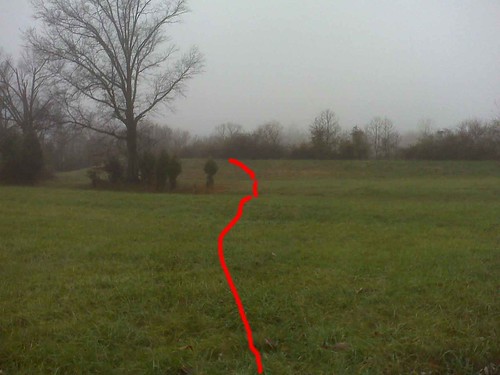
Series A 60-yard blind
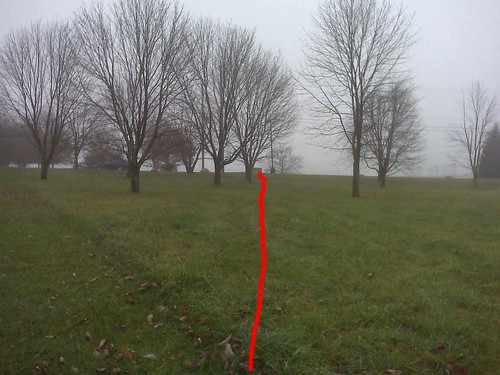
Series A 80-yard blind

Series A 140-yard blind
Today being Thanksgiving, it wasn't practical for me to take the dogs very far from home for training, but we did get in a short session:
SERIES A. Triple land blind (Laddie, then Lumi)
The first blind was to the right at 60 yards. The line to the blind was diagonally across a ditch and steep hill and past foliage on the left. The second blind was nearly 180° around to the left at 80 yards. The line to that blind was thru a wooded area and up a short slope. The third blind was in the middle at 140 yards. The line to the third blind was over a ditch and past foliage, first on the right, then on the left, forming a narrow line of sight for the last half of the blind and an opportunity for the dog to get lost out of sight on either side if she veered.
Laddie's performance was spectacular, with great WSs, accurate casts, and his exuberance in top gear. Lumi's performance was more mundane, and since she does not like to sit on wet ground, I didn't require her to sit on my whistles. But she did a good job of stopping and turning to look at me on every whistle, took good if not great casts, and never came close to requiring a Walk Out for non-responsiveness.
PHOTOS OF SERIES A

Series A 60-yard blind

Series A 80-yard blind

Series A 140-yard blind
Tuesday, November 24, 2009
First Session in Prospect Park
Prospect Park, Brooklyn, NY
The good news: Lumi and Laddie are staying with me at my new lodging in Brooklyn, as I have to spend alternate weeks in New York for my new job. I chose a place a few blocks from Prospect Park, which has huge, rolling fields plus off-leash hours 9 PM to 9 AM.
The bad news: I haven't been able to find any place up there to do water training, and I have no one to throw marks. It may be too cold for water anyway, but with L&L's Senior Hunt Tests coming up December 5-6 in South Carolina, I sure wish we could do something besides private training in the next few days.
Well, we ran some blinds on Tuesday morning. Besides the hills, the dogs had to maneuver thru keyholes formed by trees and an even more difficult challenge, other dogs and people on their route to and from the blinds. Laddie was spectacular, remaining responsive on WSs and accurate on casts despite all the distractions. Lumi found it more difficult, but did reasonably well once I got one little black dog to stop hounding her.
The good news: Lumi and Laddie are staying with me at my new lodging in Brooklyn, as I have to spend alternate weeks in New York for my new job. I chose a place a few blocks from Prospect Park, which has huge, rolling fields plus off-leash hours 9 PM to 9 AM.
The bad news: I haven't been able to find any place up there to do water training, and I have no one to throw marks. It may be too cold for water anyway, but with L&L's Senior Hunt Tests coming up December 5-6 in South Carolina, I sure wish we could do something besides private training in the next few days.
Well, we ran some blinds on Tuesday morning. Besides the hills, the dogs had to maneuver thru keyholes formed by trees and an even more difficult challenge, other dogs and people on their route to and from the blinds. Laddie was spectacular, remaining responsive on WSs and accurate on casts despite all the distractions. Lumi found it more difficult, but did reasonably well once I got one little black dog to stop hounding her.
Sunday, November 22, 2009
Preparing for Senior Hunt Tests
Rolling Ridge
It was too cold this morning for water work, so the dogs and I drove to a nearby area we've used for training in the past, a field near an abandoned farm house, for some land work.
Initially I just planned to run both dogs on Series A, an interrupted double more difficult than anything we'd see in a Senior Hunt Test, as overloaded preparation for the Seniors the dogs will be running in South Carolina in a couple of weeks.
However, Series A turned out to be too difficult for Lumi to perform well, so I also set up Series B for her as a more typical Senior-level series.
All marks were "thrown" with RLs launching weighted streamers to planted ducks. All blinds were unmarked ODs.
SERIES A. Land double interrupted with a double blind (Laddie, then Lumi)
The first mark of the double was on the left, thrown right to left at 90 yards. The second mark was 90° to the right, thrown right to left at 50 yards. After both marks were down, the dog was sent to pick up the short mark on the right. Then the dog was run on two blinds. Finally the dog was sent to pick up the longer mark on the left.
The first blind was at 120 yards, on a line to the right of the launcher for the left mark. The second blind was at 130 yards, on a line just to the left of the first mark's fall.
Factors:
Laddie ran a superb Series A, showing confidence on every retrieve. He seemed to understand at the SL that the second and third retrieves were interruptions in the double; that is, he lined up as I directed him to, made no attempt to veer toward the memory-bird while running the blinds, and remained responsive on all whistles and reasonably accurate on all casts rather than having his handling fall apart because the memory-bird was still out there. Yet he raced unhesitatingly to the memory-bird when finally sent to it, pinning it just as he had the first mark. It was a stunning performance.
Lumi's Performance
Unfortunately, Lumi, running second, had the problems I'd anticipated as possibilities. Though she was responsive on most WSs during her blinds, her casting was poor which resulted in extra WSs, and eventually she needed a WO for a slipped whistle on each blind. I attribute those problems, which are not typical of Lumi's blinds, to the presence of the memory-bird. Yet by the time she had completed both blinds and I sent her to the memory-bird, she took a few steps and stopped, a dreaded no-go, very uncharacteristic of Lumi. When I tried calling her back and sending her again, she pranced out in the right general direction but clearly had no idea where the memory-bird was.
I then reset the launchers with Lumi attached by my lead to my belt, and ran her on the simple double. She still needed a big hunt on the memory-bird.
At that point, I wanted to give Lumi more confidence on her doubles, so I moved the SL and set up Series B just for Lumi, leaving Laddie in his crate in the van.
SERIES B. Land double with blind (Lumi only)
The first mark was on the right, thrown right to left at 100 yards. The second mark was 60° to the left, thrown left to right (converging) at 40 yards. After the dog picked up both marks, the dog ran a 60-yard blind on a line just to the left of the RL for the left mark.
The memory-bird, that is, the 100-yard mark on the right, was thrown from in front of one tree to in front of another tree, and the line to the mark was across a ditch and thru an area of high, dry, prickly cover. The go-bird, that is, the 40-yard mark on the left, was in front of a wide cluster of shrubs. The blind was planted to left of another cluster of shrubs.
Lumi ran Series B nicely.
PHOTOS OF BOTH SERIES
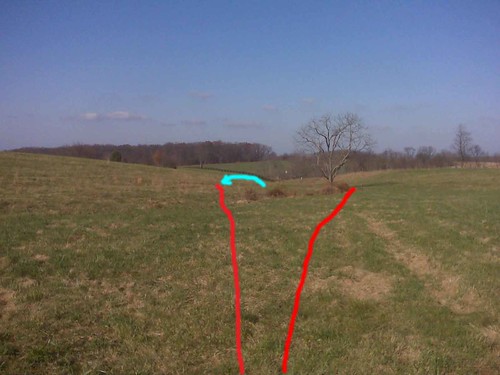
Series A 90-yard mark and 120-yard blind
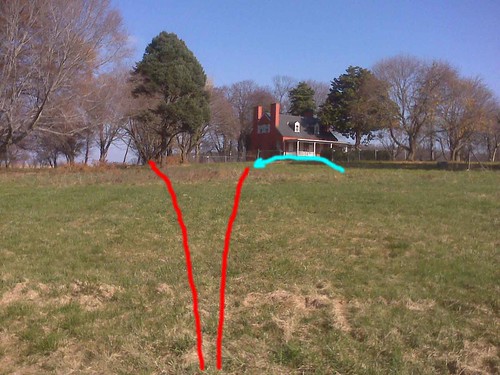
Series A 50-yard mark and 130-yard blind
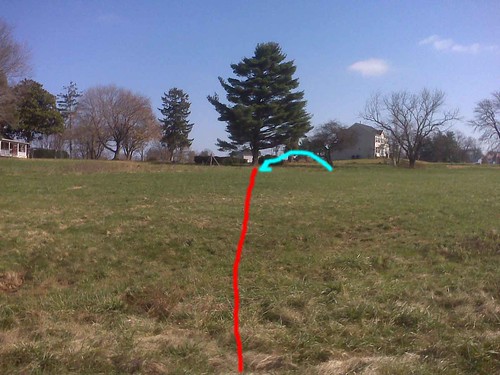
Series B 100-yard mark
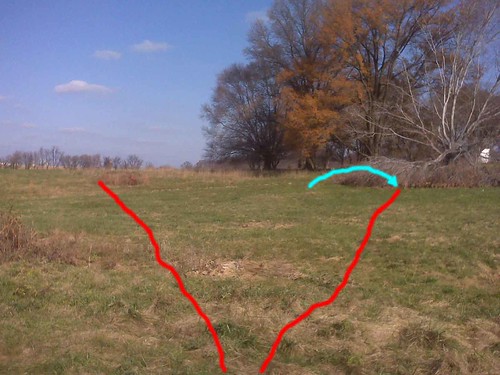
Series B 40-yard mark and 60-yard blind
It was too cold this morning for water work, so the dogs and I drove to a nearby area we've used for training in the past, a field near an abandoned farm house, for some land work.
Initially I just planned to run both dogs on Series A, an interrupted double more difficult than anything we'd see in a Senior Hunt Test, as overloaded preparation for the Seniors the dogs will be running in South Carolina in a couple of weeks.
However, Series A turned out to be too difficult for Lumi to perform well, so I also set up Series B for her as a more typical Senior-level series.
All marks were "thrown" with RLs launching weighted streamers to planted ducks. All blinds were unmarked ODs.
SERIES A. Land double interrupted with a double blind (Laddie, then Lumi)
The first mark of the double was on the left, thrown right to left at 90 yards. The second mark was 90° to the right, thrown right to left at 50 yards. After both marks were down, the dog was sent to pick up the short mark on the right. Then the dog was run on two blinds. Finally the dog was sent to pick up the longer mark on the left.
The first blind was at 120 yards, on a line to the right of the launcher for the left mark. The second blind was at 130 yards, on a line just to the left of the first mark's fall.
Factors:
- The wind blew from behind the SL toward the memory-bird (the 90-yard #1 mark on the left), so the dog could not scent either mark without running past it (for #1) or to its left (#2).
- The dog had to run into high, dry, prickly cover to pick up the go-bird.
- The dog had to go into a large depression in the ground to pick up the first blind.
- The dog had to go thru the same area of prickly cover as for the go-bird to get to the second blind, and also had to go up a step.
- The dog had to ignore the diversions of a number of trees and shrubs on the various lines.
- The dog had to traverse the hilly terrain on a variety of angles tending to pull the dog off line.
- Remembering the memory-bird on the left while running three other retrieves. This isn't only a memory problem, it's also a confidence problem. During the interruption after picking up the first mark, the dog is required to rely on the handler to find the two blinds, but afterwards, the dog must return to self-reliance to drive towards, and if necessary hunt for, the memory-bird.
- Handling well on the blinds while the memory-bird has not yet been picked up. I found when I first tried this that my dogs tended to slip whistles and take poor casts.
- As described above, the series also had a variety of other challenges.
Laddie ran a superb Series A, showing confidence on every retrieve. He seemed to understand at the SL that the second and third retrieves were interruptions in the double; that is, he lined up as I directed him to, made no attempt to veer toward the memory-bird while running the blinds, and remained responsive on all whistles and reasonably accurate on all casts rather than having his handling fall apart because the memory-bird was still out there. Yet he raced unhesitatingly to the memory-bird when finally sent to it, pinning it just as he had the first mark. It was a stunning performance.
Lumi's Performance
Unfortunately, Lumi, running second, had the problems I'd anticipated as possibilities. Though she was responsive on most WSs during her blinds, her casting was poor which resulted in extra WSs, and eventually she needed a WO for a slipped whistle on each blind. I attribute those problems, which are not typical of Lumi's blinds, to the presence of the memory-bird. Yet by the time she had completed both blinds and I sent her to the memory-bird, she took a few steps and stopped, a dreaded no-go, very uncharacteristic of Lumi. When I tried calling her back and sending her again, she pranced out in the right general direction but clearly had no idea where the memory-bird was.
I then reset the launchers with Lumi attached by my lead to my belt, and ran her on the simple double. She still needed a big hunt on the memory-bird.
At that point, I wanted to give Lumi more confidence on her doubles, so I moved the SL and set up Series B just for Lumi, leaving Laddie in his crate in the van.
SERIES B. Land double with blind (Lumi only)
The first mark was on the right, thrown right to left at 100 yards. The second mark was 60° to the left, thrown left to right (converging) at 40 yards. After the dog picked up both marks, the dog ran a 60-yard blind on a line just to the left of the RL for the left mark.
The memory-bird, that is, the 100-yard mark on the right, was thrown from in front of one tree to in front of another tree, and the line to the mark was across a ditch and thru an area of high, dry, prickly cover. The go-bird, that is, the 40-yard mark on the left, was in front of a wide cluster of shrubs. The blind was planted to left of another cluster of shrubs.
Lumi ran Series B nicely.
PHOTOS OF BOTH SERIES

Series A 90-yard mark and 120-yard blind

Series A 50-yard mark and 130-yard blind

Series B 100-yard mark

Series B 40-yard mark and 60-yard blind
Friday, November 20, 2009
Eliminating Verbal Recall
During the last week, we've trained almost every day. We've trained three times at Cheltenham, once on a nearby field, and once, today, at Twin Ponds.
The day we trained on the field, Lumi and Laddie each ran a triple blind, 50-90-140 yards.
The other days were all land-water-land retrieves. I had given up on water work earlier this fall because the weather had gotten so cold, but it warmed up again and I'm seriously considering running them in a double Hunt Test in South Carolina in December. Accordingly, I felt we should focus on the one problem they both had in the last test, and that Laddie has had on a continuing basis, which is returning across water.
This week, I made a new change in our training procedure. The results have been so excellent that I wonder if the new procedure could have been used all along, but I'm not sure whether that would have been possible. If I ever train another retriever, I'll try it this way for sure.
The change was simply to forego any voice cues for recall. In the case of water retrieves with the bird on land, I wait for the dog to reach the duck and shake off, which both of my dogs invariably do when they get to the bird, or sometimes earlier as they get out of the water. When they are standing at the bird and have shaken off, I blow come-in whistle (CIW) one time. Our CIW has evolved to tweeeet-tweet-tweet-tweet.
For water retrieves with the bird in water (which have never been a problem) or at the shoreline, I blow CIW as soon as the dog is about to reach the bird.
Once I blow CIW, either the dog picks up the bird and comes back, or she doesn't. I give her a moment to pick up the bird, and if she doesn't do so, or if she does so but doesn't get back in the water, or if she does so but then puts it down again, I instantly call "sit" and walk around the shoreline to her. When I arrive, I slip on her lead, walk her gently back to the SL, and run her again. As I've mentioned in previous posts, I call this procedure of picking the dog up a Walk Out (WO). The important modification for this week's sessions was eliminating the voice recall, also continuing to drastically curtail tolerance for dawdling on the pickup and water re-entry.
I've used this procedure at least a dozen times with each dog. Laddie has had almost no WOs, while Lumi has had 4-5 WOs total. In not one instance has either dog required a second WO on the same retrieve, and both dogs have had fewer and fewer need for WOs as the week has progressed, with neither dog requiring a WO in either yesterday's session at Cheltenham or today's session at Twin Ponds. To me, that adds to the evidence that the WO has at least a short-term reinforcing effect on high-quality pickups and returns.
Eliminating the voice recall seems to have strengthened the effectiveness of the WO. Perhaps this is because it simplifies the context and response equation for the dog. Perhaps it's because the verbal recall acts as a reinforcer for the undesired behavior of dawdling, and eliminating that reinforcer has led in the direction of extinction of the dawdling. Perhaps some other force is at work. For whatever reason, it seems clear that use of a voice recall is detrimental to my dogs' performance, at least at this stage in their development.
We also continued with change I made a month ago, but it has only applied to Lumi, as it turns out. That change was to permit the dog to run the bank on returns, while still requiring a straight line from the SL to the bird. Laddie has not attempted this, though I would permit it, even encourage it, if he did so. Lumi, on the other hand, has taken advantage of this option several times, and it seems to have significantly improved her confidence and motivation. I only regret not teaching it to her earlier in her career. As mentioned in an earlier post, she would have earned her Senior Hunter title on our last test if she had known this option was available to her.
The photo below shows one of our more challenging and interesting retrieves over the last week. The distance is 100 yards, and the line requires the dog to go on and off one point, then past a second point on the right. Another challenge is that section of water on the far side of the first point is a stickpond with considerable underwater debris as well as tree stumps visible at the surface.
Lumi, running second, had great difficulty being handled into the stickpond, requiring many casts as she repeatedly tried to stay on the first point, veer right to the second point, or come back in toward the SL, all in order to avoid the stickpond. She did finally complete the retrieve, however, and had no difficulty with her return, on which she steered to the left side of the debris, then turned back in toward the first point.
When Laddie ran this retrieve, by contrast, he leapt into the water, accepted handling to keep him from veering too far right as he swam hard to the first point, took a WSC back off the first point with a second exuberant big air water entry, drove hard toward the lining pole with complete disregard for debris, decoys, tree stumps, leaves and any other diversion, grabbed the dummy (I had inadvertently left our ducks at home for this session), trotted back into the water, and swam straight back, again ignoring the second point and then crossing the first point, finally climbing out and cheerfully delivering his prize. I was stunned at the quality of his performance and how easy he made it look.
PHOTO OF ONE OF TODAY'S WATER RETRIEVES
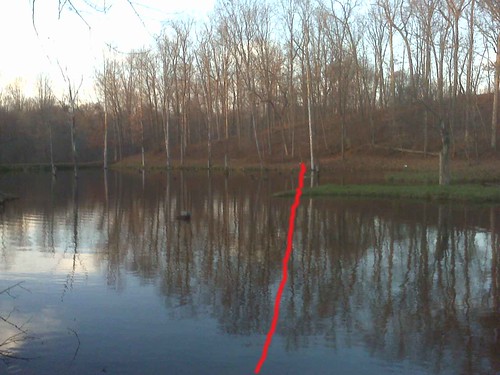
The day we trained on the field, Lumi and Laddie each ran a triple blind, 50-90-140 yards.
The other days were all land-water-land retrieves. I had given up on water work earlier this fall because the weather had gotten so cold, but it warmed up again and I'm seriously considering running them in a double Hunt Test in South Carolina in December. Accordingly, I felt we should focus on the one problem they both had in the last test, and that Laddie has had on a continuing basis, which is returning across water.
This week, I made a new change in our training procedure. The results have been so excellent that I wonder if the new procedure could have been used all along, but I'm not sure whether that would have been possible. If I ever train another retriever, I'll try it this way for sure.
The change was simply to forego any voice cues for recall. In the case of water retrieves with the bird on land, I wait for the dog to reach the duck and shake off, which both of my dogs invariably do when they get to the bird, or sometimes earlier as they get out of the water. When they are standing at the bird and have shaken off, I blow come-in whistle (CIW) one time. Our CIW has evolved to tweeeet-tweet-tweet-tweet.
For water retrieves with the bird in water (which have never been a problem) or at the shoreline, I blow CIW as soon as the dog is about to reach the bird.
Once I blow CIW, either the dog picks up the bird and comes back, or she doesn't. I give her a moment to pick up the bird, and if she doesn't do so, or if she does so but doesn't get back in the water, or if she does so but then puts it down again, I instantly call "sit" and walk around the shoreline to her. When I arrive, I slip on her lead, walk her gently back to the SL, and run her again. As I've mentioned in previous posts, I call this procedure of picking the dog up a Walk Out (WO). The important modification for this week's sessions was eliminating the voice recall, also continuing to drastically curtail tolerance for dawdling on the pickup and water re-entry.
I've used this procedure at least a dozen times with each dog. Laddie has had almost no WOs, while Lumi has had 4-5 WOs total. In not one instance has either dog required a second WO on the same retrieve, and both dogs have had fewer and fewer need for WOs as the week has progressed, with neither dog requiring a WO in either yesterday's session at Cheltenham or today's session at Twin Ponds. To me, that adds to the evidence that the WO has at least a short-term reinforcing effect on high-quality pickups and returns.
Eliminating the voice recall seems to have strengthened the effectiveness of the WO. Perhaps this is because it simplifies the context and response equation for the dog. Perhaps it's because the verbal recall acts as a reinforcer for the undesired behavior of dawdling, and eliminating that reinforcer has led in the direction of extinction of the dawdling. Perhaps some other force is at work. For whatever reason, it seems clear that use of a voice recall is detrimental to my dogs' performance, at least at this stage in their development.
We also continued with change I made a month ago, but it has only applied to Lumi, as it turns out. That change was to permit the dog to run the bank on returns, while still requiring a straight line from the SL to the bird. Laddie has not attempted this, though I would permit it, even encourage it, if he did so. Lumi, on the other hand, has taken advantage of this option several times, and it seems to have significantly improved her confidence and motivation. I only regret not teaching it to her earlier in her career. As mentioned in an earlier post, she would have earned her Senior Hunter title on our last test if she had known this option was available to her.
The photo below shows one of our more challenging and interesting retrieves over the last week. The distance is 100 yards, and the line requires the dog to go on and off one point, then past a second point on the right. Another challenge is that section of water on the far side of the first point is a stickpond with considerable underwater debris as well as tree stumps visible at the surface.
Lumi, running second, had great difficulty being handled into the stickpond, requiring many casts as she repeatedly tried to stay on the first point, veer right to the second point, or come back in toward the SL, all in order to avoid the stickpond. She did finally complete the retrieve, however, and had no difficulty with her return, on which she steered to the left side of the debris, then turned back in toward the first point.
When Laddie ran this retrieve, by contrast, he leapt into the water, accepted handling to keep him from veering too far right as he swam hard to the first point, took a WSC back off the first point with a second exuberant big air water entry, drove hard toward the lining pole with complete disregard for debris, decoys, tree stumps, leaves and any other diversion, grabbed the dummy (I had inadvertently left our ducks at home for this session), trotted back into the water, and swam straight back, again ignoring the second point and then crossing the first point, finally climbing out and cheerfully delivering his prize. I was stunned at the quality of his performance and how easy he made it look.
PHOTO OF ONE OF TODAY'S WATER RETRIEVES

Sunday, November 8, 2009
Lumi's Low Thyroid
[This is a note I sent to Alice and Jody about Lumi's low thyroid.]
Here's something I don't think I've mentioned.
I'm 99% convinced that a large part of Lumi's pickup-speed problem was low thyroid. The problem has largely disappeared since she's been on thyroid Rx.
I have never really understood Lumi's slow pickup. She wants to complete the retrieve, she wants the next retrieve, she's not especially distracted by the environment (unlike a certain other dog who shall go unnamed). So what's the problem?
OK, I can see that cold water is a problem. Big problem for 2Q dogs, I think. But never mind that.
What about the pickup for a land retrieve? Why should that have ever been a problem for Lumi?
I think the answer might have been energy level. Often Lumi would run out, then walk the bird or dummy back. In fact, her returns were getting slower and slower over time, one of the reasons I wondered if she'd stay sound enough to make it to Master.
I now think that the return had an aversive quality because of her low thyroid, minimal food intake, and low energy. Her slow pick-ups might have been an avoidance, or at least postponement, response.
I also noticed that her feet seemed much more sensitive to certain terrains than other dogs. I'm not sure if that might also be a thyroid issue, or might be an allergy issue.
Oh, they may be tied in. Low thyroid has skin allergies as one of its symptoms.
Anyway, it's wonderful to see Lumi run out, pick up the bird or dummy, and run it all the way back in. That's what I'm seeing more and more.
I can hardly wait for competition to start again in the good weather. Lumi's just a hair's breadth from her SH. Laddie's not much further.
LL&L
Here's something I don't think I've mentioned.
I'm 99% convinced that a large part of Lumi's pickup-speed problem was low thyroid. The problem has largely disappeared since she's been on thyroid Rx.
I have never really understood Lumi's slow pickup. She wants to complete the retrieve, she wants the next retrieve, she's not especially distracted by the environment (unlike a certain other dog who shall go unnamed). So what's the problem?
OK, I can see that cold water is a problem. Big problem for 2Q dogs, I think. But never mind that.
What about the pickup for a land retrieve? Why should that have ever been a problem for Lumi?
I think the answer might have been energy level. Often Lumi would run out, then walk the bird or dummy back. In fact, her returns were getting slower and slower over time, one of the reasons I wondered if she'd stay sound enough to make it to Master.
I now think that the return had an aversive quality because of her low thyroid, minimal food intake, and low energy. Her slow pick-ups might have been an avoidance, or at least postponement, response.
I also noticed that her feet seemed much more sensitive to certain terrains than other dogs. I'm not sure if that might also be a thyroid issue, or might be an allergy issue.
Oh, they may be tied in. Low thyroid has skin allergies as one of its symptoms.
Anyway, it's wonderful to see Lumi run out, pick up the bird or dummy, and run it all the way back in. That's what I'm seeing more and more.
I can hardly wait for competition to start again in the good weather. Lumi's just a hair's breadth from her SH. Laddie's not much further.
LL&L
Triple with Reverse Hip Pocket and Blind
Oaks Area 2
On a gorgeous fall day, we continued our preparation for Master tests next year.
Training alone, we used RLs with weighted streamers and frozen ducks for the marks, ODs for the blind.
The terrain was calf-length cover, thorny in places, with uneven footing.
SERIES A. Land triple with reverse hip pocket and blind (Laddie, then Lumi)
The first mark was on the left, thrown right to left at 70 yards. The second mark was in the center, thrown left to right at 100 yards. The third mark was on the right, thrown left to right at 50 yards. The line to the second mark ran just behind (on the left of) the RL for the third mark. After the dog had picked up the three marks, the dog ran a 160-yard blind to the left of the left mark.
The first mark, the final memory-bird, had a row of trees 50 yards further back as a backdrop, providing possible suction for the dog to overrun that mark, since marks are often thrown near the treeline.
All first and second marks were planted in cover. The third mark, the go-bird, was in a tractor wheel's rut.
The line to the 160-yard blind was thru a keyhole formed by a break in a line of trees at 140 yards.
OBJECTIVES OF SERIES A
Series A was designed with several training objectives in mind:
NOTE ON RETIRED GUNS WITH REMOTE LAUNCHERS
These days, I rarely use stickmen with RLs, so in effect all guns are "retired". Usually that strengthens the challenge and requires the dogs to pick up visual data such as background scenery rather than depending on the sight of the thrower.
However, today's challenge on the second mark might have been made more difficult if I'd used a stickman at the RL for the shorter third mark, since that might have thrown the dog's line on the longer mark off line or even made the longer mark more difficult to remember. I'll try to bring along a stickman for next time I run a hip pocket or reverse hip pocket.
PERFORMANCE NOTES
Though both dogs bowed around areas of thorny ground cover on two of the marks, they both ran to all three birds with enthusiasm, showing confidence in their focus and lines from the moment I lined them up.
As always, both dogs also had exuberant send-outs on the blind. For the return, Laddie has always run training dummies back, and Lumi used to do so. Now that Lumi has been on thyroid medication for several weeks, she has once again been doing so, rather than walking them back as she had been doing increasingly earlier this year.
PHOTOS OF SERIES A
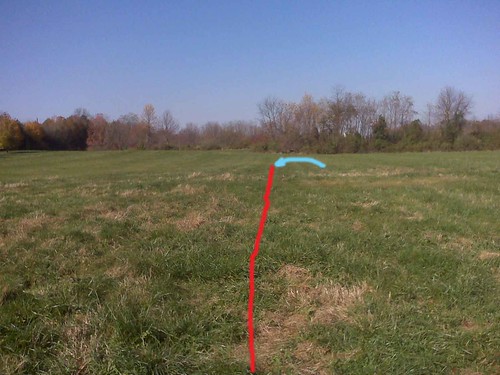
Series A 70-yard memory-bird, first down, last retrieved
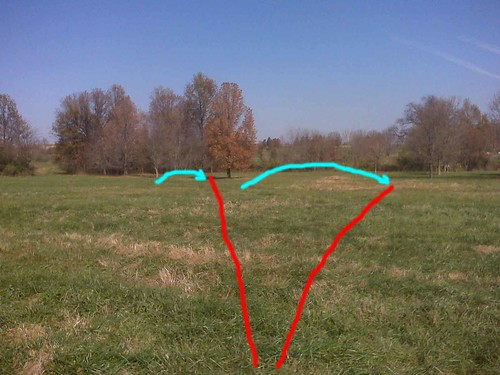
Series A 100-yard and 50-yard reverse-hip pocket
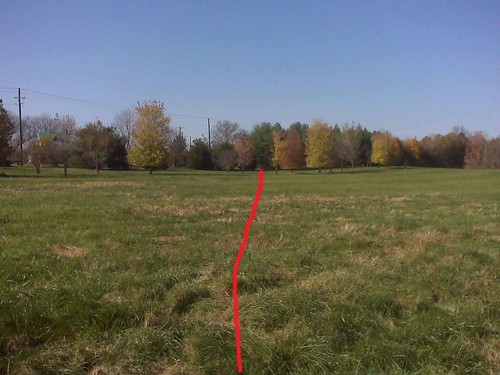
Series A 160-yard keyhole blind
On a gorgeous fall day, we continued our preparation for Master tests next year.
Training alone, we used RLs with weighted streamers and frozen ducks for the marks, ODs for the blind.
The terrain was calf-length cover, thorny in places, with uneven footing.
SERIES A. Land triple with reverse hip pocket and blind (Laddie, then Lumi)
The first mark was on the left, thrown right to left at 70 yards. The second mark was in the center, thrown left to right at 100 yards. The third mark was on the right, thrown left to right at 50 yards. The line to the second mark ran just behind (on the left of) the RL for the third mark. After the dog had picked up the three marks, the dog ran a 160-yard blind to the left of the left mark.
The first mark, the final memory-bird, had a row of trees 50 yards further back as a backdrop, providing possible suction for the dog to overrun that mark, since marks are often thrown near the treeline.
All first and second marks were planted in cover. The third mark, the go-bird, was in a tractor wheel's rut.
The line to the 160-yard blind was thru a keyhole formed by a break in a line of trees at 140 yards.
OBJECTIVES OF SERIES A
Series A was designed with several training objectives in mind:
- Practice a triple mark, something Alice has emphasized as a key for Master preparation
- Practice a keyhole blind
- Practice a reverse hip-pocket double, in which the long mark is thrown "on the heels" of the short thrower, that is, so that it lands on a line that runs just behind the short Gun
- If the dog had needed handling on the second mark (the long throw of the reverse hip-pocket), the dog would still need to run with confidence on the last memory-bird, the first bird down and the only bird thrown right to left; this objective was not met in today's session, because neither of my dogs needed handling on any of the marks
NOTE ON RETIRED GUNS WITH REMOTE LAUNCHERS
These days, I rarely use stickmen with RLs, so in effect all guns are "retired". Usually that strengthens the challenge and requires the dogs to pick up visual data such as background scenery rather than depending on the sight of the thrower.
However, today's challenge on the second mark might have been made more difficult if I'd used a stickman at the RL for the shorter third mark, since that might have thrown the dog's line on the longer mark off line or even made the longer mark more difficult to remember. I'll try to bring along a stickman for next time I run a hip pocket or reverse hip pocket.
PERFORMANCE NOTES
Though both dogs bowed around areas of thorny ground cover on two of the marks, they both ran to all three birds with enthusiasm, showing confidence in their focus and lines from the moment I lined them up.
As always, both dogs also had exuberant send-outs on the blind. For the return, Laddie has always run training dummies back, and Lumi used to do so. Now that Lumi has been on thyroid medication for several weeks, she has once again been doing so, rather than walking them back as she had been doing increasingly earlier this year.
PHOTOS OF SERIES A

Series A 70-yard memory-bird, first down, last retrieved

Series A 100-yard and 50-yard reverse-hip pocket

Series A 160-yard keyhole blind
Saturday, November 7, 2009
First Quad
West of Zion Park
SERIES A. Quadruple land marks with blind (Laddie, then Lumi)
This was the first quad either of my dogs has run, or at least the first I can remember.
All marks were "thrown" with an RL and weighted streamers, using a pre-positioned, frozen duck. The blind was an OD.
The first mark was at middle right, thrown right to left at 100 yards. The second mark was at middle left, thrown right to left at 70 yards. The third mark was on the far right, thrown right to left at 60 yards. The fourth and last mark, the go-bird, was on the far left, thrown left to right at 50 yards. The 230-yard blind, run after the dog had picked up all the marks, was between the first and third marks, and also thru a keyhole formed by huge powerline towers. All five retrieves were contained within a 120° angle.
The terrain for this series was calf-high cover with uneven footing and some thorny foliage. The backdrop was woods, which turned out to be a factor for Lumi on the go-bird. She has apparently become accustomed to birds being planted near the treeline when woods are the backdrop, and for the go-bird, the treeline was at 100 yards, while the throw was only at 50 yards. That didn't fool Laddie, but Lumi ran right over the bird and all the way to the treeline, then needed to be handled back so she wouldn't go after the second bird down, which was at the treeline. Unfortunately, the come-in cast is the most difficult for Lumi, and while she remained nice and responsive on every WS, she took a lot of WSCs before she finally came in and got to the bird.
Aside from that, Lumi took good lines and did a reasonable job on her other three marks, and handled reasonably well on the longish blind.
By contrast, Laddie, who had run first, did an outstanding job on this, his first quad. He ran with purpose straight to every mark, picked it up and raced back. He then handled beautifully on the blind. His only flaw was that on his third send-out, when I intended that he pick up the second mark at 70 yards, he decided immediately he was going to pick up the longer first mark at 100 yards, a bit to the right of where I sent him, instead. I was concerned that he might have forgotten the second mark, but no, when he got back with his third bird and I lined him up for the second mark, he locked in on the correct line immediately and nailed it. He made the whole series look easy.
SERIES A. Quadruple land marks with blind (Laddie, then Lumi)
This was the first quad either of my dogs has run, or at least the first I can remember.
All marks were "thrown" with an RL and weighted streamers, using a pre-positioned, frozen duck. The blind was an OD.
The first mark was at middle right, thrown right to left at 100 yards. The second mark was at middle left, thrown right to left at 70 yards. The third mark was on the far right, thrown right to left at 60 yards. The fourth and last mark, the go-bird, was on the far left, thrown left to right at 50 yards. The 230-yard blind, run after the dog had picked up all the marks, was between the first and third marks, and also thru a keyhole formed by huge powerline towers. All five retrieves were contained within a 120° angle.
The terrain for this series was calf-high cover with uneven footing and some thorny foliage. The backdrop was woods, which turned out to be a factor for Lumi on the go-bird. She has apparently become accustomed to birds being planted near the treeline when woods are the backdrop, and for the go-bird, the treeline was at 100 yards, while the throw was only at 50 yards. That didn't fool Laddie, but Lumi ran right over the bird and all the way to the treeline, then needed to be handled back so she wouldn't go after the second bird down, which was at the treeline. Unfortunately, the come-in cast is the most difficult for Lumi, and while she remained nice and responsive on every WS, she took a lot of WSCs before she finally came in and got to the bird.
Aside from that, Lumi took good lines and did a reasonable job on her other three marks, and handled reasonably well on the longish blind.
By contrast, Laddie, who had run first, did an outstanding job on this, his first quad. He ran with purpose straight to every mark, picked it up and raced back. He then handled beautifully on the blind. His only flaw was that on his third send-out, when I intended that he pick up the second mark at 70 yards, he decided immediately he was going to pick up the longer first mark at 100 yards, a bit to the right of where I sent him, instead. I was concerned that he might have forgotten the second mark, but no, when he got back with his third bird and I lined him up for the second mark, he locked in on the correct line immediately and nailed it. He made the whole series look easy.
Thursday, November 5, 2009
Delayed, Interrupted Triple with Blind
Nearby Field
SERIES A. Delayed, interrupted land triple with blind (Laddie, then Lumi)
For today's series, I used three remote launchers with weighted streamers and pre-positioned frozen ducks, and an OD for the blind.
The first mark was on the right, thrown right to left at 60 yards on an angle back from the RL. After the dog watched the first mark thrown, the dog was handled to the 160-yard blind to 75° to the left, then sent to pick up the first mark. With the dog accompanying me on lead, I then placed a duck at 70 yards nearly in line with the blind. Back at the SL, I used another RL to throw another mark on the right, thrown right to left at 110 yards on an angle in from the RL, and on a line that took the dog thru the fall from the first mark. The last throw was on the right, left to right at 70 yards, the bird that I had gone out and planted after the dog had picked up the first mark and the blind. After the last two throws, the dog was sent to the 70-yard mark on the left, then the 110 yard mark on the right.
As I understand the terminology, this was an interrupted series because the dog ran the blind after watching the first mark thrown, but before picking it up. And this was a delayed series because the last two marks were not thrown until the dog had picked up the blind and the first mark.
OBJECTIVES
My primary objective with this series was for Lumi and Laddie to practice running a blind even though a mark had been thrown and not picked up. Both dogs did well, with no attempt to veer toward the first duck while running the blind.
A second objective was to work on memory-birds. The second mark was a memory-bird because it was run after the dog picked up the third mark as the go-bird first. That was a normal double. The first mark was also a memory-bird, but a more unusual one in that the dog was first handled to the blind, then had to remember the memory-bird that had been thrown earlier. Both dogs retrieved that memory-bird without handling, but Lumi pinned it whereas Laddie required a moderate hunt to find it.
An objective related to the second objective was giving the dogs practice with retired guns, that is, gun stations where the thrower disappears from sight after throwing the mark. One advantage to working with RLs is that they are usually invisible from the SL, effectively acting as retired guns.
A third objective was practice with a convergent double, the second and third marks.
A fourth objective was practicing an angle-back and an angle-in throw, the first and second marks respectively.
A fifth objective was practicing running thru a previous fall, from the first mark, to get to a later bird, the second mark. This was difficult for two separate reasons. First, advanced dogs have learned not to run the same line twice, so in the unusual case where they are sent on the same line, they tend to veer around the first fall, taking them off the line to the second fall. Second, if they stay on the correct line or find their way back to it, they can be distracted by scent from earlier falls on the shorter throw and have difficulty driving thru the area of that fall to the longer fall where the bird is.
In addition to those challenges, another objective was to build motivation by rewarding the difficulties of handling on the blind, and the interrupted retrieve of the first mark, with the relatively easy and exciting double of the second and third marks.
PHOTOS OF SERIES A
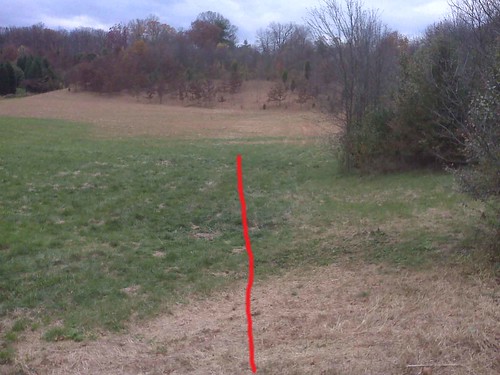
Series A 60-yard mark
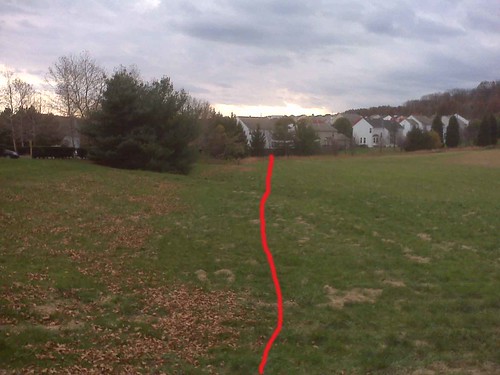
Series A 160-yard blind
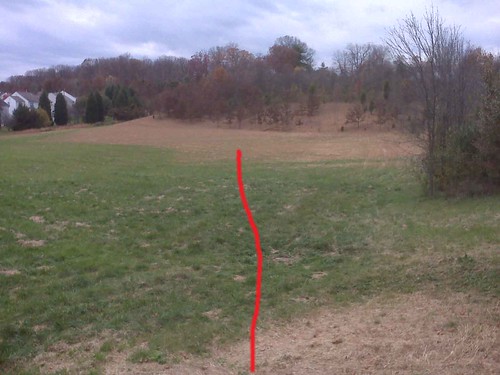
Series A 110-yard mark
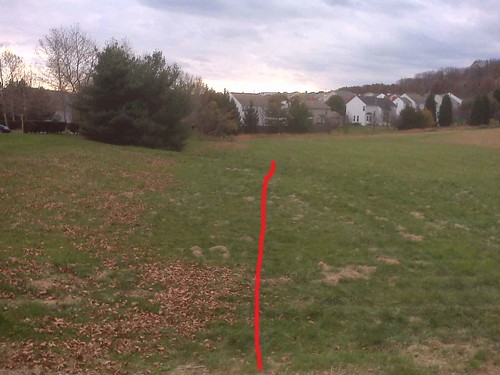
Series A 70-yard mark
SERIES A. Delayed, interrupted land triple with blind (Laddie, then Lumi)
For today's series, I used three remote launchers with weighted streamers and pre-positioned frozen ducks, and an OD for the blind.
The first mark was on the right, thrown right to left at 60 yards on an angle back from the RL. After the dog watched the first mark thrown, the dog was handled to the 160-yard blind to 75° to the left, then sent to pick up the first mark. With the dog accompanying me on lead, I then placed a duck at 70 yards nearly in line with the blind. Back at the SL, I used another RL to throw another mark on the right, thrown right to left at 110 yards on an angle in from the RL, and on a line that took the dog thru the fall from the first mark. The last throw was on the right, left to right at 70 yards, the bird that I had gone out and planted after the dog had picked up the first mark and the blind. After the last two throws, the dog was sent to the 70-yard mark on the left, then the 110 yard mark on the right.
As I understand the terminology, this was an interrupted series because the dog ran the blind after watching the first mark thrown, but before picking it up. And this was a delayed series because the last two marks were not thrown until the dog had picked up the blind and the first mark.
OBJECTIVES
My primary objective with this series was for Lumi and Laddie to practice running a blind even though a mark had been thrown and not picked up. Both dogs did well, with no attempt to veer toward the first duck while running the blind.
A second objective was to work on memory-birds. The second mark was a memory-bird because it was run after the dog picked up the third mark as the go-bird first. That was a normal double. The first mark was also a memory-bird, but a more unusual one in that the dog was first handled to the blind, then had to remember the memory-bird that had been thrown earlier. Both dogs retrieved that memory-bird without handling, but Lumi pinned it whereas Laddie required a moderate hunt to find it.
An objective related to the second objective was giving the dogs practice with retired guns, that is, gun stations where the thrower disappears from sight after throwing the mark. One advantage to working with RLs is that they are usually invisible from the SL, effectively acting as retired guns.
A third objective was practice with a convergent double, the second and third marks.
A fourth objective was practicing an angle-back and an angle-in throw, the first and second marks respectively.
A fifth objective was practicing running thru a previous fall, from the first mark, to get to a later bird, the second mark. This was difficult for two separate reasons. First, advanced dogs have learned not to run the same line twice, so in the unusual case where they are sent on the same line, they tend to veer around the first fall, taking them off the line to the second fall. Second, if they stay on the correct line or find their way back to it, they can be distracted by scent from earlier falls on the shorter throw and have difficulty driving thru the area of that fall to the longer fall where the bird is.
In addition to those challenges, another objective was to build motivation by rewarding the difficulties of handling on the blind, and the interrupted retrieve of the first mark, with the relatively easy and exciting double of the second and third marks.
PHOTOS OF SERIES A

Series A 60-yard mark

Series A 160-yard blind

Series A 110-yard mark

Series A 70-yard mark
Sunday, November 1, 2009
Land Blinds
Nearby Field
SERIES A. Triple land blind (Laddie, then Lumi)
The first blind was to the right at 60-yards, across hilly terrain and thru a narrow keyhole formed by conifers. The second blind was in the middle at 70-yards, with diagonal hill crossings. The third blind was to the left at 140-yards, with diagonal hill crossings on a tight angle to the preceding blind.
PHOTOS OF SERIES A
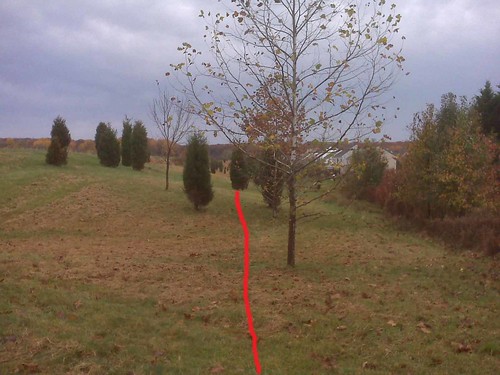
Series A 60-yard blind

Series A 140-yard and 70-yard blinds
SERIES A. Triple land blind (Laddie, then Lumi)
The first blind was to the right at 60-yards, across hilly terrain and thru a narrow keyhole formed by conifers. The second blind was in the middle at 70-yards, with diagonal hill crossings. The third blind was to the left at 140-yards, with diagonal hill crossings on a tight angle to the preceding blind.
PHOTOS OF SERIES A

Series A 60-yard blind

Series A 140-yard and 70-yard blinds
Saturday, October 31, 2009
Assisted Walk Outs and Bulldogs
Cheltenham
Today's session was almost identical to last weekend's, four AWO's combined with bulldogs, with Austin assisting.
The only difference was that today, for the first three series, I gave Austin the instruction that on both the first retrieve well onto shore, and the second retrieve at water's edge, for each series, Austin was to wait three seconds and then begin toward the dog, without waiting for me to say anything and without giving the dog a chance to reposition the bird or any other seemingly reasonable delay.
For the forth series, I asked Austin to wait until I told him to walk toward the dog on each of the retrieves, and it was not necessary for any of them.
Today's session was almost identical to last weekend's, four AWO's combined with bulldogs, with Austin assisting.
The only difference was that today, for the first three series, I gave Austin the instruction that on both the first retrieve well onto shore, and the second retrieve at water's edge, for each series, Austin was to wait three seconds and then begin toward the dog, without waiting for me to say anything and without giving the dog a chance to reposition the bird or any other seemingly reasonable delay.
For the forth series, I asked Austin to wait until I told him to walk toward the dog on each of the retrieves, and it was not necessary for any of them.
Sunday, October 25, 2009
Assisted Walk Outs and Bulldogs
Cheltenham
Because I was working in New York all of last week, and will be there again next week, and because I wasn't able to get out with the dogs yesterday, today was our only training session over a period of nearly two weeks.
To make the most of it, I brought along Austin, a neighborhood kid who's helped with training earlier this year as well.
Both of my dogs have done well with most requirements of the Senior Hunt Test for some time, with one exception: both are unreliable on their returns for water retrieves. This single fault prevented both of them from qualifying in their last test a week ago.
Two address this, Gaby and I began working with the dogs on what I call an Assisted Walk Out (AWO) last Sunday. Today's session was again devoted to the AWO.
Over a period of just under two hours, I set up four series, all the same except that they were in four different locations. Each series was as follows:
The bad news is that in the fourth series, Lumi again required an AWO. This could mean that the AWO is only a short-term solution. Or it may simply mean that my dogs have a well-ingrained habit of dawdling on pick-ups and returns and it's going to take a lot of practice with the AWO to replace that habit with the one I want.
Because I was working in New York all of last week, and will be there again next week, and because I wasn't able to get out with the dogs yesterday, today was our only training session over a period of nearly two weeks.
To make the most of it, I brought along Austin, a neighborhood kid who's helped with training earlier this year as well.
Both of my dogs have done well with most requirements of the Senior Hunt Test for some time, with one exception: both are unreliable on their returns for water retrieves. This single fault prevented both of them from qualifying in their last test a week ago.
Two address this, Gaby and I began working with the dogs on what I call an Assisted Walk Out (AWO) last Sunday. Today's session was again devoted to the AWO.
Over a period of just under two hours, I set up four series, all the same except that they were in four different locations. Each series was as follows:
- On my signal, Austin held a duck up for the dog to see, then dropped the duck at the base of a lining pole set back from the bank varying distances (closer at first, further back for the later series), on the opposite side of an inlet. He then walked to a point 10 yards to the left or right and closer to water's edge, remaining as inconspicuous as possible as he walked and took up his new position, holding a second bird.
- As soon as Austin had taken a few steps, I sent the dog. Each dog became confused in one of the series and swam toward Austin, in which cases I handled the dog to the lining pole. Aside from those incidents, the dog swam straight toward the pole, climbed out of the water, and raced to the pole and the bird.
- If the dog picked the bird up immediately (I allowed the dog to shake if desired, which happened almost every time) and got back in the water, I cheered and applauded. Then, when the dog was well into her swim back, I called for Austin to throw a "bulldog", that is, another mark while the dog is retrieving the previous one. The bulldog included a gunshot, and was thrown either on shore near the water or in water near the shore. If the dog showed any inclination to turn toward the bulldog, I called her to me. In general, Lumi ignored the bulldogs while Laddie looked at them, but neither dog tried to change direction in most cases. As soon as the dog got to me with the first bird, I took the bird without even bringing the dog heel, gestured in the direction of the bulldog to get the dog turned around, and sent her as soon as she was looking the right way.
- If the dog cheated around the water on the return (Lumi did this several times, Laddie did not), I did nothing to discourage it while it was happening. If Lumi had done that in our last test, she'd have her Senior Hunter title now, so I don't want to outright ban it. But I then took the bird, brought it back to Austin, and ran the retrieve again. The goal wasn't to use attrition to change her cheating return (which is legal in a Senior test, I believe), but to give her a chance to earn the bulldog by coming back over water.
- If the dog came straight back with the bulldog, I cheered again, and this time I threw my own bulldog with the first duck, this time into open water to one side or the other. Again, as soon as the dog arrived with the bulldog, I sent her to the open-water retrieve.
- If the dog dawdled on either the original retrieve or the bulldog, I used an AWO. That is, I called to Austin to pick up the bird, called out "Sit" to the dog, and walked around to pick the dog up. I then slipped on her lead, walked her back to the SL, and ran the identical retrieve again.
The bad news is that in the fourth series, Lumi again required an AWO. This could mean that the AWO is only a short-term solution. Or it may simply mean that my dogs have a well-ingrained habit of dawdling on pick-ups and returns and it's going to take a lot of practice with the AWO to replace that habit with the one I want.
Monday, October 12, 2009
Hunt Test Preparation
Cheltenham
Time is so short these days, trying to combine training with my new consulting position, taking me to New York the last three weeks. I've found it especially difficult to get around to typing up my training notes in this blog.
Anyway, today Lumi, Laddie and I again trained with Gaby at Cheltenham. This time she brought both of her Senior dogs (that is, dogs training for Senior Hunt Test competition): Buster (yellow Lab) and Gus (Chessie).
SERIES A. Land double with blind
The first throw (memory-bird) was to the left, a duck thrown right to left on an angle-in into high cover at 60 yards. The second throw (go-bird) was to the right, a Bumper Boy throwing right to left at 50 yards. The blind (OD marked with orange ribbon) was to the left of the left mark, at 70 yards in high cover.
Lumi and Laddie both did well on this series. The only problem was that Lumi decided to run to the duck first, then pick up the Bumper Boy's bumper. Since she nailed both of them, I guess it was all right.
SERIES B. Water double with blind
The first throw (memory-bird) was to the right, a duck thrown left to right onto a strip of land making a 60-yard LWL mark. The second throw (go-bird) was to the left, a duck thrown right to left into open water 20 feet down a channel, with the intent that the dog would run 20 yards on land, launch from the end of the channel, and swim out to the bird and back within the channel. The 50-yard blind was to the right of the right mark, an OD on the far edge of a 30-yard swim diagonally across a channel, with an angle entry on the way out and of an angle exit coming back.
The throw for Laddie was too close to the thrower (Gaby), and instead of swimming the channel, he ran the bank and leapt into the water, actually landing on the duck. He came out the same way. Since he's a good channel swimmer, I wasn't worried about it. On the other hand, his returns on the memory-bird and blind were mediocre.
Because Lumi's been having difficulty remembering doubles, I had Gaby throw her memory-bird onto the far embankment, so that it was out of sight until Lumi swam across the channel and then ran across the strip of land. She did need a small hunt, but she didn't seem to forget the bird and didn't need help. However, she took a long time picking it up. It was frozen solid and Gaby said Lumi seemed to have difficulty finding a good grip. While I think that's true, I also think that she could have managed if she'd wanted to.
Lumi also behaved somewhat oddly on her send-out to the blind, as though she were resisting getting into the water. It was cold, but I didn't think it was that cold. On the other hand, she is now on thyroid meds, yeast meds, allergy injections, many joint supplements, and she has a bare spot on her chest from the skin allergy test, so it's possible she has some water-temp sensitivity right now that she doesn't usually have.
Both dogs are showing outstanding technical skills these days but are still having trouble with the most fundamental basic, the pick-up and return. I can only hope that it won't be a problem this Saturday, when they're both entered in their next Senior Hunt Test.
Time is so short these days, trying to combine training with my new consulting position, taking me to New York the last three weeks. I've found it especially difficult to get around to typing up my training notes in this blog.
Anyway, today Lumi, Laddie and I again trained with Gaby at Cheltenham. This time she brought both of her Senior dogs (that is, dogs training for Senior Hunt Test competition): Buster (yellow Lab) and Gus (Chessie).
SERIES A. Land double with blind
The first throw (memory-bird) was to the left, a duck thrown right to left on an angle-in into high cover at 60 yards. The second throw (go-bird) was to the right, a Bumper Boy throwing right to left at 50 yards. The blind (OD marked with orange ribbon) was to the left of the left mark, at 70 yards in high cover.
Lumi and Laddie both did well on this series. The only problem was that Lumi decided to run to the duck first, then pick up the Bumper Boy's bumper. Since she nailed both of them, I guess it was all right.
SERIES B. Water double with blind
The first throw (memory-bird) was to the right, a duck thrown left to right onto a strip of land making a 60-yard LWL mark. The second throw (go-bird) was to the left, a duck thrown right to left into open water 20 feet down a channel, with the intent that the dog would run 20 yards on land, launch from the end of the channel, and swim out to the bird and back within the channel. The 50-yard blind was to the right of the right mark, an OD on the far edge of a 30-yard swim diagonally across a channel, with an angle entry on the way out and of an angle exit coming back.
The throw for Laddie was too close to the thrower (Gaby), and instead of swimming the channel, he ran the bank and leapt into the water, actually landing on the duck. He came out the same way. Since he's a good channel swimmer, I wasn't worried about it. On the other hand, his returns on the memory-bird and blind were mediocre.
Because Lumi's been having difficulty remembering doubles, I had Gaby throw her memory-bird onto the far embankment, so that it was out of sight until Lumi swam across the channel and then ran across the strip of land. She did need a small hunt, but she didn't seem to forget the bird and didn't need help. However, she took a long time picking it up. It was frozen solid and Gaby said Lumi seemed to have difficulty finding a good grip. While I think that's true, I also think that she could have managed if she'd wanted to.
Lumi also behaved somewhat oddly on her send-out to the blind, as though she were resisting getting into the water. It was cold, but I didn't think it was that cold. On the other hand, she is now on thyroid meds, yeast meds, allergy injections, many joint supplements, and she has a bare spot on her chest from the skin allergy test, so it's possible she has some water-temp sensitivity right now that she doesn't usually have.
Both dogs are showing outstanding technical skills these days but are still having trouble with the most fundamental basic, the pick-up and return. I can only hope that it won't be a problem this Saturday, when they're both entered in their next Senior Hunt Test.
Saturday, October 10, 2009
Full House, Adventure Drill
Oaks Area 2
SERIES A. Double land retrieve with triple blind (Laddie, then Lumi)
This is one of my favorite kinds of set-ups, and Lumi and Laddie also seem to like it. A nickname for it could be a Full House, since it combines two of a kind (the double marks) with three of a kind (the triple blind).
For the marks, I used RLs, weighted streamers, and ducks. For the blinds, I used ODs. I fired a pistol before each "throw" from the RLs.
The first mark (memory-bird) was on the left, thrown right to left at 60 yards. The second mark (go-bird) was on the right, thrown right to left at 30 yards.
After the dog picked up both marks, the dog ran the three blinds. The first blind was a little to the right of the right RL at 60 yards, past a tree on the right with the blind at the foot of a tree. The second blind was in the center, a little to the left of the right mark, to the left of a gap in a line of trees at 90 yards. The third blind was to the left of the left mark at 130 yards, 20 yards past the end of a line of trees on the right.
Both dogs pinned each mark, then responded reasonably well for handling on each blind. Laddie's handling, in fact, was excellent.
Lumi's handling was more than acceptable by Senior standards (from my experience), but not as good as Laddie's, in that Lumi didn't carry her casts well but instead to scallop back in the direction I had cast her away from. She also slipped a whistle at 110 yards on the third blind and I responded with a WO, but she her other WSs both before and after that lapse were excellent.
Laddie was his usual exuberant self. Lumi, who is now on both thyroid medication and allergy injections, in addition to her long running course of joint supplements, showed lovely energy and motivation, racing out as usual, but also running back in on all her retrieves.
PHOTOS OF SERIES A

Series A 60-yard mark (memory-bird)
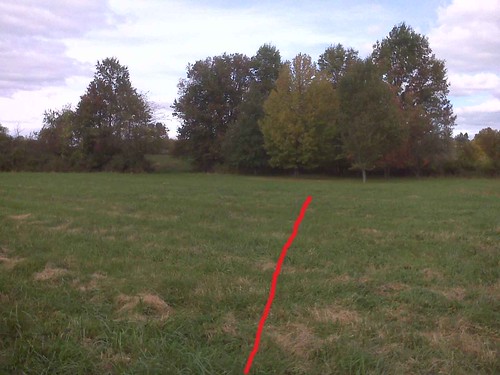
Series A 30-yard mark (go-bird)
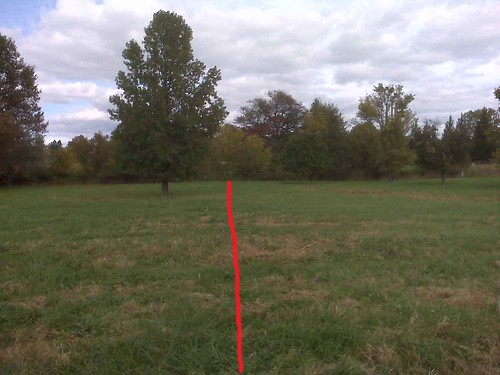
Series A 60-yard blind
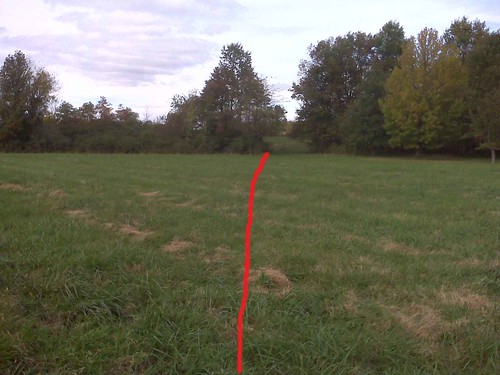
Series A 90-yard blind
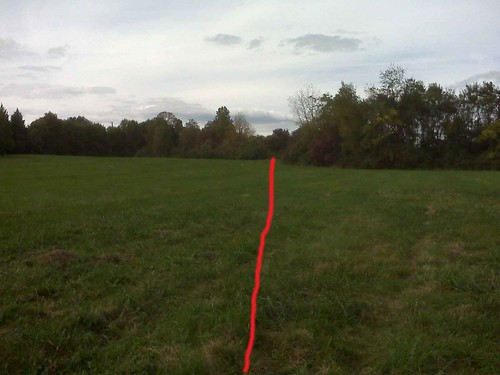
Series A 130-yard blind
Sundown Road Park
After we completed Series A, we drove to nearby Sundown for a little Adventure Drill: five short retrieves thru extremely difficult footing, each time over a creek and into tangled undergrowth. With no appreciable rain in weeks, the creek was low, and only a couple of the crossings required any swimming.
SERIES A. Double land retrieve with triple blind (Laddie, then Lumi)
This is one of my favorite kinds of set-ups, and Lumi and Laddie also seem to like it. A nickname for it could be a Full House, since it combines two of a kind (the double marks) with three of a kind (the triple blind).
For the marks, I used RLs, weighted streamers, and ducks. For the blinds, I used ODs. I fired a pistol before each "throw" from the RLs.
The first mark (memory-bird) was on the left, thrown right to left at 60 yards. The second mark (go-bird) was on the right, thrown right to left at 30 yards.
After the dog picked up both marks, the dog ran the three blinds. The first blind was a little to the right of the right RL at 60 yards, past a tree on the right with the blind at the foot of a tree. The second blind was in the center, a little to the left of the right mark, to the left of a gap in a line of trees at 90 yards. The third blind was to the left of the left mark at 130 yards, 20 yards past the end of a line of trees on the right.
Both dogs pinned each mark, then responded reasonably well for handling on each blind. Laddie's handling, in fact, was excellent.
Lumi's handling was more than acceptable by Senior standards (from my experience), but not as good as Laddie's, in that Lumi didn't carry her casts well but instead to scallop back in the direction I had cast her away from. She also slipped a whistle at 110 yards on the third blind and I responded with a WO, but she her other WSs both before and after that lapse were excellent.
Laddie was his usual exuberant self. Lumi, who is now on both thyroid medication and allergy injections, in addition to her long running course of joint supplements, showed lovely energy and motivation, racing out as usual, but also running back in on all her retrieves.
PHOTOS OF SERIES A

Series A 60-yard mark (memory-bird)

Series A 30-yard mark (go-bird)

Series A 60-yard blind

Series A 90-yard blind

Series A 130-yard blind
Sundown Road Park
After we completed Series A, we drove to nearby Sundown for a little Adventure Drill: five short retrieves thru extremely difficult footing, each time over a creek and into tangled undergrowth. With no appreciable rain in weeks, the creek was low, and only a couple of the crossings required any swimming.
Sunday, October 4, 2009
Hunt Test Preparation
Cheltenham
Today we trained with Gaby and Gus, one of Gaby's Chessies.
SERIES A. Water blind (Laddie, then Lumi)
Series A was a channel blind, requiring the dog to swim along the length of a long, narrow, somewhat winding channel without veering offline to touch shore on either side until the dog reached the location where an OD was planted.
SERIES B. Water double (Laddie, then Lumi)
We ran Series B in the property's stick pond.
SERIES C. Double land blind (Laddie, then Lumi)
The first blind was thru a narrow keyhole. The second blind was along a hillside.
SERIES D. Water double and water blind (Laddie, then Lumi)
We returned to the stick pond for Series D.
Today we trained with Gaby and Gus, one of Gaby's Chessies.
SERIES A. Water blind (Laddie, then Lumi)
Series A was a channel blind, requiring the dog to swim along the length of a long, narrow, somewhat winding channel without veering offline to touch shore on either side until the dog reached the location where an OD was planted.
SERIES B. Water double (Laddie, then Lumi)
We ran Series B in the property's stick pond.
SERIES C. Double land blind (Laddie, then Lumi)
The first blind was thru a narrow keyhole. The second blind was along a hillside.
SERIES D. Water double and water blind (Laddie, then Lumi)
We returned to the stick pond for Series D.
Sunday, September 27, 2009
Blinds, Adventure Drill
Milestone
SERIES A. 160-yard land blind (Laddie, then Lumi)
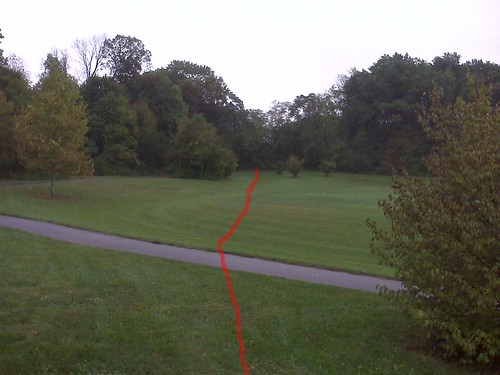
Series A 160-yard blind
SERIES B. 130-yard land blind (Laddie, then Lumi)

Series B 130-yard blind
Black Hill Regional Park
SERIES C. Adventure Drill
Based on correspondence with Alice Woodyard, I'm increasingly convinced that the Adventure Drill (AD) has played an important role in improving Laddie's returns during events, especially on LWL retrieves. In fact, while practicing blinds seems vital in order to assure that the dogs will be responsive to handling when we run competition blinds, Alice pointed out that handling may well be somewhat aversive to one or both of my dogs. That could condition the dogs to some extent to resist returning, as a way of avoiding the subsequent retrieve, which might be a handling retrieve. It makes sense that the AD would provide the opposite conditioning, a non-handling and exciting retrieve to look forward to. And the evidence seems to support the hypothesis: Laddie's returns in events improved dramatically after I first introduced the AD last spring; his returns in events declined in the quality after I stopped using the AD during the summer (thinking it was no longer necessary); and his returns improved again when I brought the AD back during the week between his first and second events of the fall. He then qualified in both events that second weekend.
SERIES D. 130-yard land blind (Laddie, then Lumi)
Sorry, no photos for Series C and D.
Seneca Creek off Frederick Avenue
SERIES E. Adventure Drill
Today we discovered a new place to run our Adventure Drill, a creek with swim-depth water, at least at this time. The volume of water was so high, in fact, that as the dogs crossed the creek out and back for each retrieve, the current tugged at them, trying to carry them downstream, and they had to fight it to complete their crossings. Neither dog showed any reluctance to re-enter the water, so I believe the current just added to the adventure.
Since we'd already worked quite a bit today before we discovered this new location, I limited our work at this location to two retrieves.
Photos of Series E
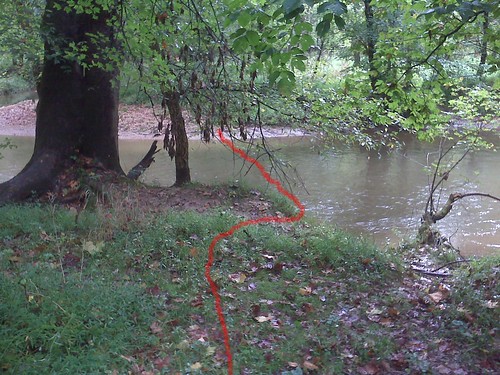
Series E retrieve #1

Series E retrieve #2
SERIES A. 160-yard land blind (Laddie, then Lumi)

Series A 160-yard blind
SERIES B. 130-yard land blind (Laddie, then Lumi)

Series B 130-yard blind
Black Hill Regional Park
SERIES C. Adventure Drill
Based on correspondence with Alice Woodyard, I'm increasingly convinced that the Adventure Drill (AD) has played an important role in improving Laddie's returns during events, especially on LWL retrieves. In fact, while practicing blinds seems vital in order to assure that the dogs will be responsive to handling when we run competition blinds, Alice pointed out that handling may well be somewhat aversive to one or both of my dogs. That could condition the dogs to some extent to resist returning, as a way of avoiding the subsequent retrieve, which might be a handling retrieve. It makes sense that the AD would provide the opposite conditioning, a non-handling and exciting retrieve to look forward to. And the evidence seems to support the hypothesis: Laddie's returns in events improved dramatically after I first introduced the AD last spring; his returns in events declined in the quality after I stopped using the AD during the summer (thinking it was no longer necessary); and his returns improved again when I brought the AD back during the week between his first and second events of the fall. He then qualified in both events that second weekend.
SERIES D. 130-yard land blind (Laddie, then Lumi)
Sorry, no photos for Series C and D.
Seneca Creek off Frederick Avenue
SERIES E. Adventure Drill
Today we discovered a new place to run our Adventure Drill, a creek with swim-depth water, at least at this time. The volume of water was so high, in fact, that as the dogs crossed the creek out and back for each retrieve, the current tugged at them, trying to carry them downstream, and they had to fight it to complete their crossings. Neither dog showed any reluctance to re-enter the water, so I believe the current just added to the adventure.
Since we'd already worked quite a bit today before we discovered this new location, I limited our work at this location to two retrieves.
Photos of Series E

Series E retrieve #1

Series E retrieve #2
Missing Posts
[I'm pleased to announce that after two months of being out of work, I started with a new consulting position last Monday, September 21. Though I'm happy to be earning income again, unfortunately, the work requires that initially, I spend a good bit of time in New York's financial district. There's no practical way for me to have my dogs with me in New York, much less train, so we did not train Monday thru Friday of last week, and the same will be true for the next two weeks. Luckily I'm able to come home on weekends.
[Meanwhile, I was so busy before the trip that I fell behind in keeping up this journal. Some important recent posts are missing, including three Senior Hunt Tests. Each of my dogs qualified in two of the three, including both dogs in the last one. I've kept notes on the various sessions, and in some cases I also have some photos. I'll do my best to transcribe them to this blog as soon as possible.]
[Meanwhile, I was so busy before the trip that I fell behind in keeping up this journal. Some important recent posts are missing, including three Senior Hunt Tests. Each of my dogs qualified in two of the three, including both dogs in the last one. I've kept notes on the various sessions, and in some cases I also have some photos. I'll do my best to transcribe them to this blog as soon as possible.]
Saturday, September 12, 2009
Land Blinds
Rolling Ridge
All work today was with ODs.
SERIES A. Double land blind (Laddie, then Lumi)
The first blind was 70 yards, the second 80 yards.
SERIES B. Triple land blind (Laddie only)
These blinds were 60, 110, and 120 yards.
All work today was with ODs.
SERIES A. Double land blind (Laddie, then Lumi)
The first blind was 70 yards, the second 80 yards.
SERIES B. Triple land blind (Laddie only)
These blinds were 60, 110, and 120 yards.
Friday, September 11, 2009
Hunt Test Preparation
Brandywine Industrial Park
Today, Lumi, Laddie and I trained with a friend on the grounds of an industrial park in Brandywine. We ran a number of retrieves, including both land and water, and marks and blinds. I did not keep detailed records.
After our friend left with her dogs, I had Laddie run one additional double blind (photos below) for a little more practice with his WSs.
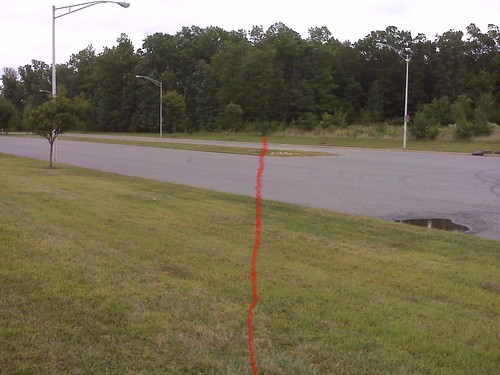
90-yard blind with angled terrain changes

100-yard blind across bowl-shaped terrain
Today, Lumi, Laddie and I trained with a friend on the grounds of an industrial park in Brandywine. We ran a number of retrieves, including both land and water, and marks and blinds. I did not keep detailed records.
After our friend left with her dogs, I had Laddie run one additional double blind (photos below) for a little more practice with his WSs.

90-yard blind with angled terrain changes

100-yard blind across bowl-shaped terrain
Thursday, September 10, 2009
Hunt Test Preparation
Mt. Ararat Farm
Today we trained with Gaby and her Lab, Buster, at Gaby's farm. Gaby was kind enough to provide live ducks for Series B and C. In every series, Laddie ran before Lumi. For most series, Buster ran after Laddie and Lumi; for Series B, Buster ran after Laddie, then again after Lumi, so that each dog had an opportunity to honor another dog's series with a live bird.
SERIES A. Triple blind
Series A was what I'll call a Fork Drill, along the lines of handling drills I've used in the past, possibly with a different name. Today's version was a Water Fork Drill and consisted of two 80-yard blinds flanking a 50-yard sight blind. The 80-yard blinds were ODs marked with orange tape tied to a few blades of grass, while the 50-yard blind was a WD marked with an orange LP. The line to all three blinds crossed a pond. The dog was handled to each of the 80-yard blinds first, then sent to the 50-yard blind.
Photo of Series A

Series A, with 80-yard blinds on left and right, and 50-yard blind and diversion in center
SERIES B. Land single and blind, then honor
The single (clipwing duck) was on the right, thrown right to left from behind a holding blind after a shotgun blast toward the woods with live ammo. The 90-yard blind (OD) was 30° to the left of the line to the mark. After running both retrieves, the dog honored the next dog from a position a few yards to the right of the SL.
SERIES C. Remote single and honor
Series C was the identical mark as Series B, with the exception that the dog was on the outside of a holding blind at the SL, while the handler was on the inside of the holding blind, while the shotgun was fired and the live duck was thrown right to left at 30 yards from behind a second holding blind at the throwing station. Once the bird was thrown, the handler came around the SL holding blind to send the dog. After retrieving the bird, the dog honored the next dog running the same retrieve.
Photo of Series B and C
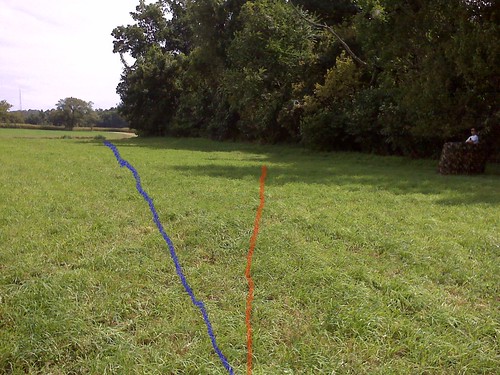
Series B and C, with 30-yard mark (red) and 90-yard blind (blue)
SERIES D. Convergent land double
The memory-bird (duck) was on the left at 120 yards, thrown left to right from the corner of a section of woods to a low area behind a crest, so that the dog could see the trajectory of the throw but could not see the fall under running the retrieve and cresting the hill. After throwing the memory-bird, the thrower retired (that is, hid from sight).
The go-bird (WD) was on the right at 40 yards, thrown right to left in open meadow.
All the dogs did well with the memory-bird, and Laddie and Buster had no difficulty with the go-bird. However, Lumi chose to run the memory-bird first and then seemed to have difficulty remembering the go-bird.
Photos of Series D

Series D go-bird
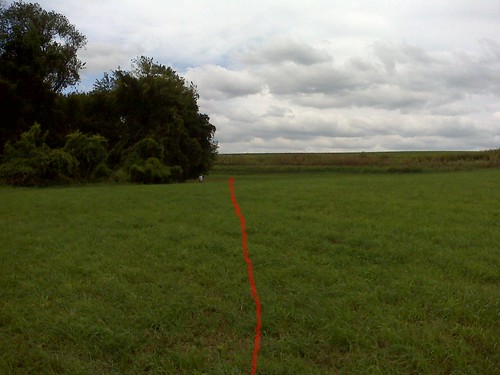
Series D memory-bird, with fall on far side of crest
SERIES E, F, and G Land doubles (Lumi only)
Series E and F were similar to Series D but in different locations, convergent land doubles with a long throw of a duck and a short throw of a WD. In each case, Lumi again decided to run the long memory-bird first.
Series G was a similar set-up in yet another location, but ducks were used for both throws. This time, Lumi ran the go-bird first, then the memory-bird.
SERIES H. Water double and blind
The memory-bird was on the left, thrown left to right at 70 yards. The line to the memory-bird was across a pond with an angle entry, thru high cover at both the entry to and exit from the water.
The go-bird was 45° to the right of the memory-bird, thrown left to right at 30 yards. The line to the go-bird was across the pond with an angle exit, thru high cover at both the entry to and exit from the water.
The 50-yard blind was 30° to the right of the line to the go-bird, across the pond, past a point on the left, and to the edge of the far shore. The dogs have run at least one blind on this line before, though not as part of a series with the same double and not with the placement of the blind at water's edge.
Photos of Series H
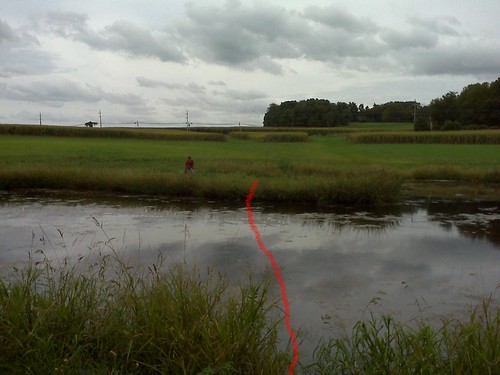
Series H go-bird
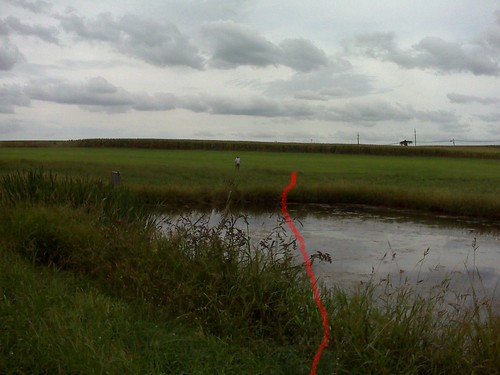
Series H memory-bird
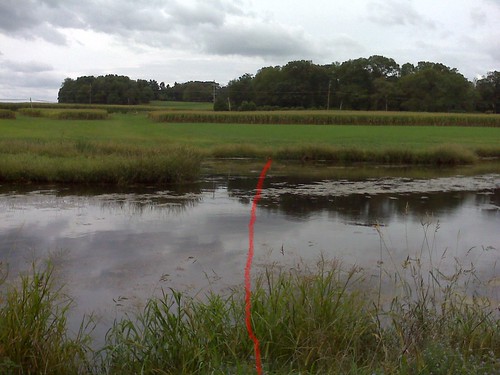
Series H water blind
Today we trained with Gaby and her Lab, Buster, at Gaby's farm. Gaby was kind enough to provide live ducks for Series B and C. In every series, Laddie ran before Lumi. For most series, Buster ran after Laddie and Lumi; for Series B, Buster ran after Laddie, then again after Lumi, so that each dog had an opportunity to honor another dog's series with a live bird.
SERIES A. Triple blind
Series A was what I'll call a Fork Drill, along the lines of handling drills I've used in the past, possibly with a different name. Today's version was a Water Fork Drill and consisted of two 80-yard blinds flanking a 50-yard sight blind. The 80-yard blinds were ODs marked with orange tape tied to a few blades of grass, while the 50-yard blind was a WD marked with an orange LP. The line to all three blinds crossed a pond. The dog was handled to each of the 80-yard blinds first, then sent to the 50-yard blind.
Photo of Series A

Series A, with 80-yard blinds on left and right, and 50-yard blind and diversion in center
SERIES B. Land single and blind, then honor
The single (clipwing duck) was on the right, thrown right to left from behind a holding blind after a shotgun blast toward the woods with live ammo. The 90-yard blind (OD) was 30° to the left of the line to the mark. After running both retrieves, the dog honored the next dog from a position a few yards to the right of the SL.
SERIES C. Remote single and honor
Series C was the identical mark as Series B, with the exception that the dog was on the outside of a holding blind at the SL, while the handler was on the inside of the holding blind, while the shotgun was fired and the live duck was thrown right to left at 30 yards from behind a second holding blind at the throwing station. Once the bird was thrown, the handler came around the SL holding blind to send the dog. After retrieving the bird, the dog honored the next dog running the same retrieve.
Photo of Series B and C

Series B and C, with 30-yard mark (red) and 90-yard blind (blue)
SERIES D. Convergent land double
The memory-bird (duck) was on the left at 120 yards, thrown left to right from the corner of a section of woods to a low area behind a crest, so that the dog could see the trajectory of the throw but could not see the fall under running the retrieve and cresting the hill. After throwing the memory-bird, the thrower retired (that is, hid from sight).
The go-bird (WD) was on the right at 40 yards, thrown right to left in open meadow.
All the dogs did well with the memory-bird, and Laddie and Buster had no difficulty with the go-bird. However, Lumi chose to run the memory-bird first and then seemed to have difficulty remembering the go-bird.
Photos of Series D

Series D go-bird

Series D memory-bird, with fall on far side of crest
SERIES E, F, and G Land doubles (Lumi only)
Series E and F were similar to Series D but in different locations, convergent land doubles with a long throw of a duck and a short throw of a WD. In each case, Lumi again decided to run the long memory-bird first.
Series G was a similar set-up in yet another location, but ducks were used for both throws. This time, Lumi ran the go-bird first, then the memory-bird.
SERIES H. Water double and blind
The memory-bird was on the left, thrown left to right at 70 yards. The line to the memory-bird was across a pond with an angle entry, thru high cover at both the entry to and exit from the water.
The go-bird was 45° to the right of the memory-bird, thrown left to right at 30 yards. The line to the go-bird was across the pond with an angle exit, thru high cover at both the entry to and exit from the water.
The 50-yard blind was 30° to the right of the line to the go-bird, across the pond, past a point on the left, and to the edge of the far shore. The dogs have run at least one blind on this line before, though not as part of a series with the same double and not with the placement of the blind at water's edge.
Photos of Series H

Series H go-bird

Series H memory-bird

Series H water blind
Wednesday, September 9, 2009
Land Blinds
Rolling Ridge
Today, I had the dogs run just a single series at a nearby field. All of the retrieves were slanted across hills, giving the dogs practice with such terrain and also increasing the opportunities for practicing WSs.
SERIES A. Triple land blind (Laddie, then Lumi)
The first blind was to the left at 90-yards. The line to the blind crossed a wide ditch on a slant and went thru a wide keyhole formed by trees.
The 130-yard second blind was 90° to the right of the first blind. The line to the second blind slanted downhill, crossed a ditch, and slanted uphill.
The 170-yard third blind was 45° to the right of the second blind. The line to the third blind traversed rolling terrain at various angles.
All marks were ODs, and no markers were used for the first and third blinds. An old, gray wooden stake marked the second blind.
Both dogs performed well on all WSs and casts. Laddie, running first, lined the 170-yard third blind.
Photos of Series A
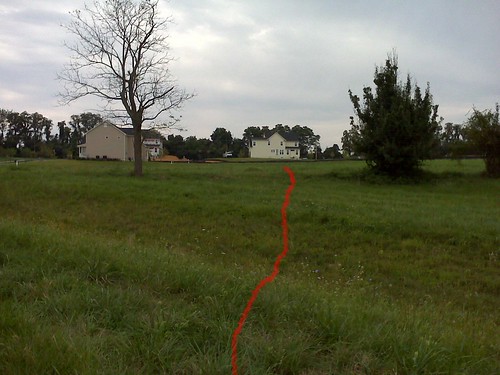
Series A 90-yard blind
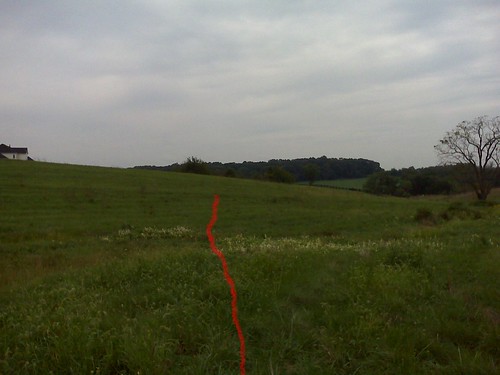
Series A 130-yard blind
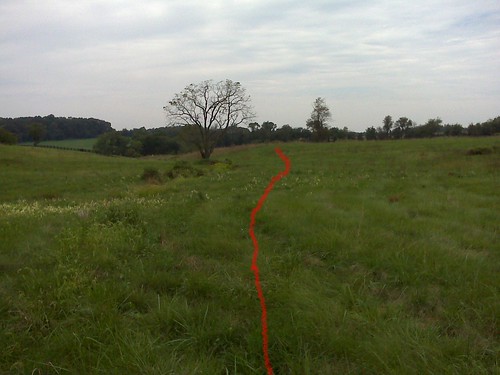
Series A 170-yard blind
Today, I had the dogs run just a single series at a nearby field. All of the retrieves were slanted across hills, giving the dogs practice with such terrain and also increasing the opportunities for practicing WSs.
SERIES A. Triple land blind (Laddie, then Lumi)
The first blind was to the left at 90-yards. The line to the blind crossed a wide ditch on a slant and went thru a wide keyhole formed by trees.
The 130-yard second blind was 90° to the right of the first blind. The line to the second blind slanted downhill, crossed a ditch, and slanted uphill.
The 170-yard third blind was 45° to the right of the second blind. The line to the third blind traversed rolling terrain at various angles.
All marks were ODs, and no markers were used for the first and third blinds. An old, gray wooden stake marked the second blind.
Both dogs performed well on all WSs and casts. Laddie, running first, lined the 170-yard third blind.
Photos of Series A

Series A 90-yard blind

Series A 130-yard blind

Series A 170-yard blind
Tuesday, September 8, 2009
Hunt Test Preparation
Mt. Ararat Farms
Training with Gaby and her Lab, Buster, we ran four series to help our dogs prepare for a Senior Hunt Test this Sunday.
SERIES A. Double blind, one land, one water
The first blind was to the right at 60 yards. The blind slanted across a downhill slope and ran past a tree on the downhill side, offering the risk that the dog would cross in front of the tree, or wrap around behind the tree after passing it.
The 130-yard second blind was 90° to the left. The second blind crossed a pond, included a swim past a point on the left, and went thru high cover at the water entry and exit.
Photos of Series A
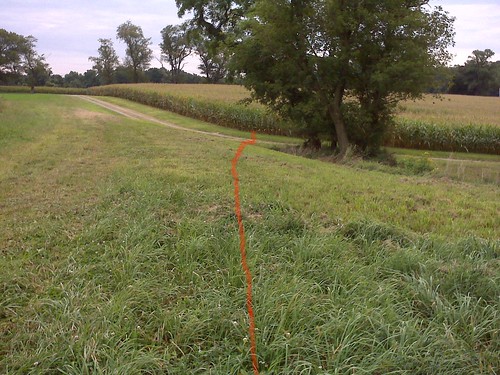
Series A 60-yard land blind
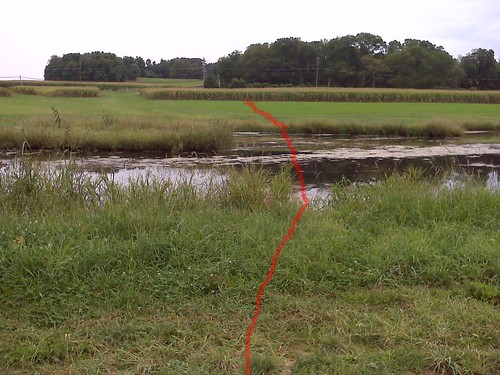
Series A 130-yard water blind
SERIES B. Land double and blind
Before the marks were thrown, the dog was positioned near a section of high cover, and the handler moved ten yards behind the dog and even with the Bumper Boy that would be used for the second mark.
After the dog and handler were positioned, the memory-bird (duck) on the left was thrown from a holding blind, left to right at 120 yards. Then the second mark (go-bird) was "thrown" by the Bumper Boy, coming from behind the dog and landing in the high cover 20 yards in front of the dog, 90° to the right of the memory-bird.
After both marks were down, the handler either walked up to the dog and sent the dog to each of the marks (that's what I did) or sent the dog while still ten yards away (that's what Gaby did).
After the dog had retrieved both marks, the dog was run on a 130-yard blind (OD) on a tight angle just to the left of the holding blind that had been used for the memory-bird.
A possible diversion, especially for Laddie, was the pond, which was just to the right of the lines to the memory-bird and the blind, but none of the dogs attempted to divert to the pond at any time.
Photos of Series B
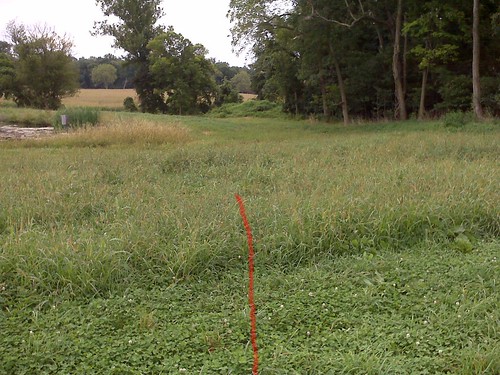
Series B 20-yard go-bird

Series B 120-yard memory-bird (red line) and 130-yard blind (blue line)
SERIES C. Converging water double
The memory-bird for this series was on the right, thrown by a Bumper Boy right to left. The trajectory was difficult to see from the SL because of high cover at both edges of the pond, and the fall was in high cover on an embankment that sloped down and away from water's edge.
The go-bird for this series was 90° to the left of the line to the memory-bird, hand-thrown left to right into the water just a few yards in front of the dog.
While the marks were being thrown, the dog was positioned in a sit in front of a holding blind at the SL, while the handler stood behind the holding blind. After the marks were down, one of the handlers (myself) walked around the holding blind to release the dog to the go-bird, while the other handler (Gaby) sent the dog while remaining behind the holding blind.
Photos of Series C
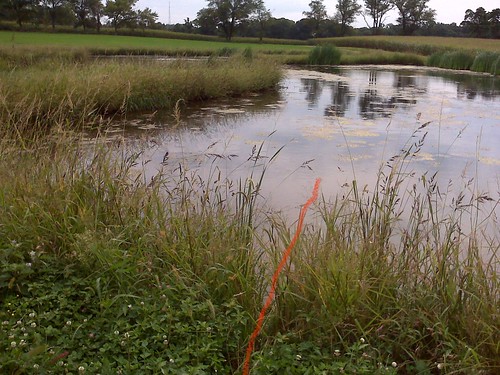
Series C 10-yard go-bird
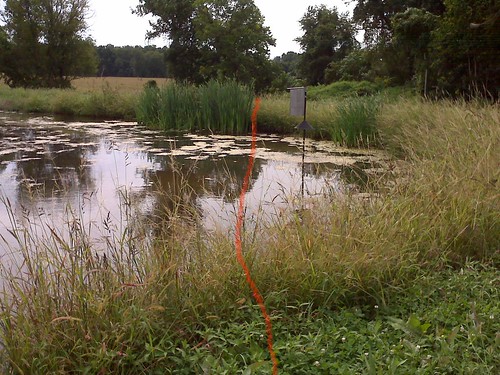
Series C 50-yard memory-bird
SERIES D. Offline drill across water
Series D was a handling drill similar to one I've used for my dogs in the past, but with the additional factor of a pond crossing. The drill consisted of three blind retrieves, as follows:
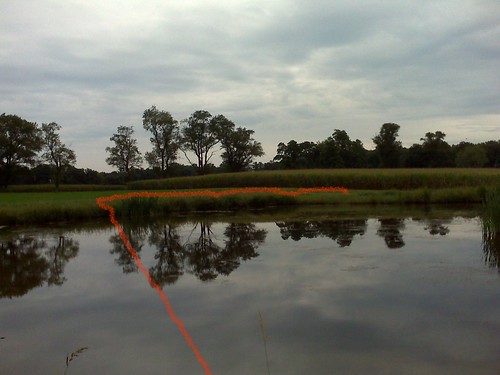
Series D 50-yard offline blind

Series D 100-yard offline blind

Series D 150-yard blind
Training with Gaby and her Lab, Buster, we ran four series to help our dogs prepare for a Senior Hunt Test this Sunday.
SERIES A. Double blind, one land, one water
The first blind was to the right at 60 yards. The blind slanted across a downhill slope and ran past a tree on the downhill side, offering the risk that the dog would cross in front of the tree, or wrap around behind the tree after passing it.
The 130-yard second blind was 90° to the left. The second blind crossed a pond, included a swim past a point on the left, and went thru high cover at the water entry and exit.
Photos of Series A

Series A 60-yard land blind

Series A 130-yard water blind
SERIES B. Land double and blind
Before the marks were thrown, the dog was positioned near a section of high cover, and the handler moved ten yards behind the dog and even with the Bumper Boy that would be used for the second mark.
After the dog and handler were positioned, the memory-bird (duck) on the left was thrown from a holding blind, left to right at 120 yards. Then the second mark (go-bird) was "thrown" by the Bumper Boy, coming from behind the dog and landing in the high cover 20 yards in front of the dog, 90° to the right of the memory-bird.
After both marks were down, the handler either walked up to the dog and sent the dog to each of the marks (that's what I did) or sent the dog while still ten yards away (that's what Gaby did).
After the dog had retrieved both marks, the dog was run on a 130-yard blind (OD) on a tight angle just to the left of the holding blind that had been used for the memory-bird.
A possible diversion, especially for Laddie, was the pond, which was just to the right of the lines to the memory-bird and the blind, but none of the dogs attempted to divert to the pond at any time.
Photos of Series B

Series B 20-yard go-bird

Series B 120-yard memory-bird (red line) and 130-yard blind (blue line)
SERIES C. Converging water double
The memory-bird for this series was on the right, thrown by a Bumper Boy right to left. The trajectory was difficult to see from the SL because of high cover at both edges of the pond, and the fall was in high cover on an embankment that sloped down and away from water's edge.
The go-bird for this series was 90° to the left of the line to the memory-bird, hand-thrown left to right into the water just a few yards in front of the dog.
While the marks were being thrown, the dog was positioned in a sit in front of a holding blind at the SL, while the handler stood behind the holding blind. After the marks were down, one of the handlers (myself) walked around the holding blind to release the dog to the go-bird, while the other handler (Gaby) sent the dog while remaining behind the holding blind.
Photos of Series C

Series C 10-yard go-bird

Series C 50-yard memory-bird
SERIES D. Offline drill across water
Series D was a handling drill similar to one I've used for my dogs in the past, but with the additional factor of a pond crossing. The drill consisted of three blind retrieves, as follows:
- The dog was sent across the pond, then whistled to a sit at 50 yards. The dog was then cast on a right Over to an OD marked by orange tape 30 yards to the dog's right.
- The dog was sent across the pond and the field beyond, then whistled to a sit at 100 yards. The dog was then cast on a left Over to an OD marked by an orange tape 30 yards to the dog's left.
- The dog was sent across the pond and the field beyond to a duck planted in front of a tree at 150 yards.

Series D 50-yard offline blind

Series D 100-yard offline blind

Series D 150-yard blind
Sunday, September 6, 2009
Blinds and Group Training
Lucky Hill Road (Remington, VA)
On the way to the group training site, I spotted an area where the dogs could air and run a couple of warm-up blinds.
SERIES A. Double land blind (Laddie, then Lumi)
The first blind (OD) was on the right at 60 yards. The line to the blind slanted across a dirt road and ended a few yards past a large tree at the edge of a section of woods.
The second blind (OD) was 45° to the left at 120 yards. The line to the second blind crossed the same dirt road, then went diagonally across a parking lot and across an area of mowed grass, and ended at the edge of a section of woods. Two outcroppings of the wooded area provided suction to the right, and an opening in the woods to the left of the blind provided suction in that direction when the dog got close to the blind.
Both dogs aired during this stop. My intent was that as a result, the dogs would not stop on their retrieves during group training. That worked for the first group series (Series B below), but both dogs did end up stopping during their second group series (Series C below) even though I attempted to air them before running them in that series.
Both dogs were responsive on all WSs and casts during Series A and did a nice job on their retrieves.
Photos of Series A
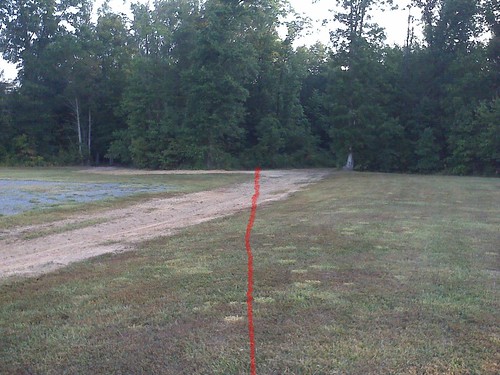
Series A's 60-yard blind
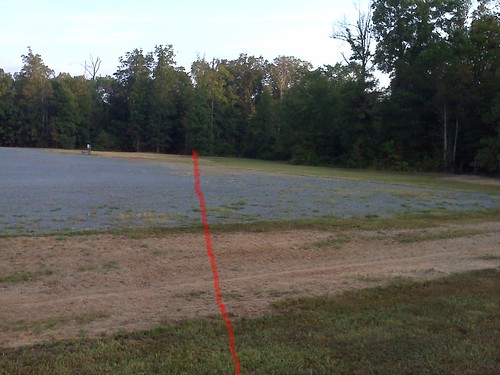
Series A's 120-yard blind
Shady Grove Kennels (Remington, VA)
This was a monthly group training day. In this post, I describe the first group series "Series B", and the second group series "Series C".
SERIES B. Double consisting of a water mark and a land mark, plus a water blind and a land blind (Laddie, then Lumi)
The memory-bird (duck) of the converging double was on the left, thrown left to right with a winger at 30 yards into high cover on the far side of a narrow inlet of water. The go-bird (duck flier) was 60° to the right, thrown right to left with a winger and shot at 80-yards. The line to the go-bird was on land, mostly thru medium-high cover.
The first blind (duck) was across water, then under the arc of the memory-bird and to a point 60 yards from our SL, marked with a lining pole. The second blind (B&W dummy) was from a different SL. The line to the 50-yard second blind was thru a wooded area and a keyhole formed by two trees, ending at an LP at the edge of a section of woods.
The line to the memory-bird required a sharp angle entry, causing the majority of dogs, including Laddie, to cheat around the water on the right. I moved our SL closer to the water to run Laddie hoping to avoid the cheat, but it didn't work. I then moved our SL even closer to the water when it was Lumi's turn.
Laddie's performance on this series had several behavioral problems. First, as we approached my intended SL, he ran ahead and jumped in the water, apparently to cool off in the hot weather. When I got him back to the SL, he did fine on the go-bird flier, but he cheated around the water on the short memory-bird. Worst of all, I think, was that on his return from the memory-bird, he stopped to roll in some high grass. Laddie had no problem with either blind.
With Lumi, I brought her right to the edge of the water. Unfortunately, Lumi forgot the memory-bird by the time she ran it as part of the double and ended up swimming across the channel well to the left of the correct line, and I was unable to handle her to the mark with a reasonable number of WSCs. At the suggestion of the "judge", I called her back to me across the channel and we ran the mark again as a single. Lumi did fine, taking the angle entry and making no effort to cheat to the right. Lumi needed more handling on both blinds than Laddie, and was especially affected by the suction from the area of falls for the memory-bird of the double, which was only a few yards to the right of the line to the first blind.
The photos are in the sequence the retrieves were run.
Photos of Series B
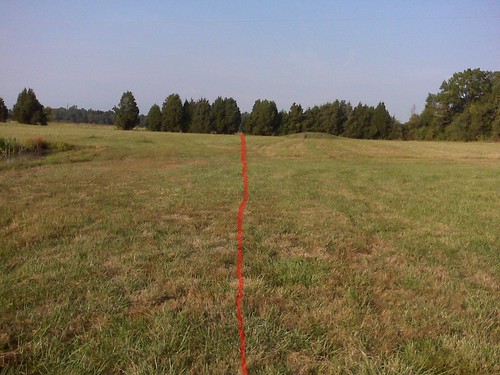
Series B's 80-yard go-bird
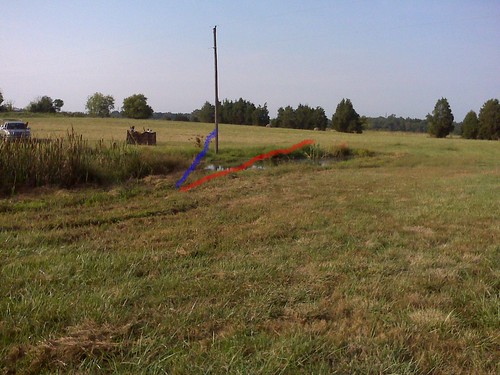
Series B's 30-yard memory-bird (red line) and 60-yard first blind (blue line) under the arc of the memory-bird's throw

Series B's 50-yard second blind
SERIES C. Water double, water single, and water blind (Laddie, then Lumi)
While some trainers ran this series as a triple and a blind from a separate SL, and some ran it as three or fewer singles with or without the blind, I decided to follow the lead of one of the other trainers: Lumi and Laddie ran this series as a double and then a single, before running the blind from a separate SL.
The memory-bird (duck) of the double was on the right, thrown right to left with a winger from behind a stand of cattails at 70 yards. The line to the memory bird slanted down an embankment, took an angle entry into a corner of the pond, and an angle-entry out of the water to the bird a few feet inland from water's edge.
The go-bird (duck) of the double was 90° to the left, thrown right t0 left with a winger at 60 yards. The intent was that the go-bird would land in open water, and that's where it landed for Lumi's series, but for Laddie, the go-bird fell short and landed in a section of cattails just past the shoreline. Even for Lumi's series, the go-bird was not visible once it had landed, but was hidden by a point of land.
The line to the single (duck) was 15° to the left of the line to the left mark of the double. The 50-yard single was thrown left to right with a winger not visible from the SL, and landed amongst a cluster of trees and in medium-high cover near water's edge. In some cases including Laddie's series, the bird hit branches of one of the trees when thrown and landed short, making it even more difficult to see the fall from the SL. Wherever the single fell, the line to the fall was on a slant down the embankment from the SL, an angle entry into the water, thru a narrowing of the water closely passing an area of high thick cover made up mostly of cattails on the left, across another short area of water, and a short ways inland into the cluster of trees after reaching the far shore.
The blind consisted of a 60-yard shoreline swim, with old, gray trees on the left creating a channel with the shoreline for the dog's line to the blind. The blind itself was a dummy placed a few yards inland from the far shore. Because of the high cover and terrain at water's edge, the dummy was not visible until the dog had climbed out of the water and thru the cover at water's edge.
Laddie did a nice job on the double. Laddie's go-bird seemed especially difficult, because for some reason it had fallen into a thick section of reeds at water's edge rather than over those reeds and into the open water, as it was thrown for the other dogs. Nonetheless, Laddie ran straight to the fall and boldly plunged down into the water for the pick-up, then clambered back up and raced home, making it look easy.
However, after completing the double and watching the single thrown (it hit a tree branch and like the go-bird of the double, fell short), Laddie did a terrible job retrieving the single. He swam straight to it, but when he got to the area of the fall, instead of picking up the duck, he ate grass, peed a couple of times on nearby trees, and dawdled in other ways before finally picking up the bird and completing the return. As I understand it, while judges are not thrilled with dogs who dawdle, pee, etc. after picking up the bird, they are especially hard in their scoring of dogs who do those things before they've picked up the bird, as was the case with Laddie on this retrieve.
Lumi did a nice job on all her retrieves in this series. She swam around the point on the memory-bird instead of climbing over the point, but I felt it was still a good Senior-level retrieve.
Photos of Series C
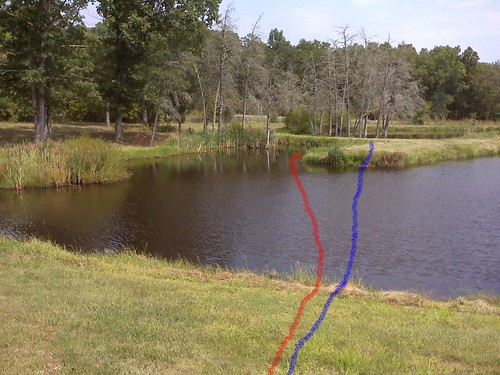
Series C's 60-yard go-bird, showing Laddie's line in blue and Lumi's line in red

Series C's 70-yard memory-bird
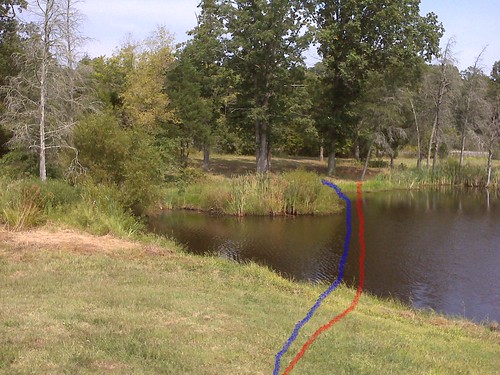
Series C's 50-yard single, showing Laddie's line in blue and Lumi's line in red
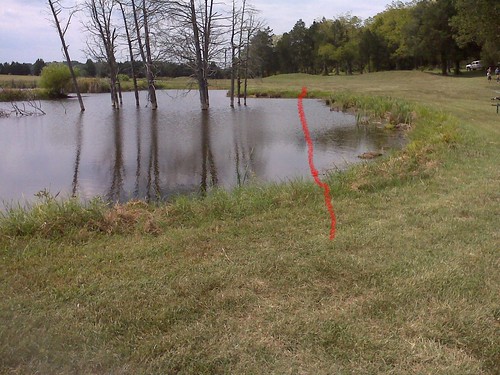
Series C's 60-yard blind
On the way to the group training site, I spotted an area where the dogs could air and run a couple of warm-up blinds.
SERIES A. Double land blind (Laddie, then Lumi)
The first blind (OD) was on the right at 60 yards. The line to the blind slanted across a dirt road and ended a few yards past a large tree at the edge of a section of woods.
The second blind (OD) was 45° to the left at 120 yards. The line to the second blind crossed the same dirt road, then went diagonally across a parking lot and across an area of mowed grass, and ended at the edge of a section of woods. Two outcroppings of the wooded area provided suction to the right, and an opening in the woods to the left of the blind provided suction in that direction when the dog got close to the blind.
Both dogs aired during this stop. My intent was that as a result, the dogs would not stop on their retrieves during group training. That worked for the first group series (Series B below), but both dogs did end up stopping during their second group series (Series C below) even though I attempted to air them before running them in that series.
Both dogs were responsive on all WSs and casts during Series A and did a nice job on their retrieves.
Photos of Series A

Series A's 60-yard blind

Series A's 120-yard blind
Shady Grove Kennels (Remington, VA)
This was a monthly group training day. In this post, I describe the first group series "Series B", and the second group series "Series C".
SERIES B. Double consisting of a water mark and a land mark, plus a water blind and a land blind (Laddie, then Lumi)
The memory-bird (duck) of the converging double was on the left, thrown left to right with a winger at 30 yards into high cover on the far side of a narrow inlet of water. The go-bird (duck flier) was 60° to the right, thrown right to left with a winger and shot at 80-yards. The line to the go-bird was on land, mostly thru medium-high cover.
The first blind (duck) was across water, then under the arc of the memory-bird and to a point 60 yards from our SL, marked with a lining pole. The second blind (B&W dummy) was from a different SL. The line to the 50-yard second blind was thru a wooded area and a keyhole formed by two trees, ending at an LP at the edge of a section of woods.
The line to the memory-bird required a sharp angle entry, causing the majority of dogs, including Laddie, to cheat around the water on the right. I moved our SL closer to the water to run Laddie hoping to avoid the cheat, but it didn't work. I then moved our SL even closer to the water when it was Lumi's turn.
Laddie's performance on this series had several behavioral problems. First, as we approached my intended SL, he ran ahead and jumped in the water, apparently to cool off in the hot weather. When I got him back to the SL, he did fine on the go-bird flier, but he cheated around the water on the short memory-bird. Worst of all, I think, was that on his return from the memory-bird, he stopped to roll in some high grass. Laddie had no problem with either blind.
With Lumi, I brought her right to the edge of the water. Unfortunately, Lumi forgot the memory-bird by the time she ran it as part of the double and ended up swimming across the channel well to the left of the correct line, and I was unable to handle her to the mark with a reasonable number of WSCs. At the suggestion of the "judge", I called her back to me across the channel and we ran the mark again as a single. Lumi did fine, taking the angle entry and making no effort to cheat to the right. Lumi needed more handling on both blinds than Laddie, and was especially affected by the suction from the area of falls for the memory-bird of the double, which was only a few yards to the right of the line to the first blind.
The photos are in the sequence the retrieves were run.
Photos of Series B

Series B's 80-yard go-bird

Series B's 30-yard memory-bird (red line) and 60-yard first blind (blue line) under the arc of the memory-bird's throw

Series B's 50-yard second blind
SERIES C. Water double, water single, and water blind (Laddie, then Lumi)
While some trainers ran this series as a triple and a blind from a separate SL, and some ran it as three or fewer singles with or without the blind, I decided to follow the lead of one of the other trainers: Lumi and Laddie ran this series as a double and then a single, before running the blind from a separate SL.
The memory-bird (duck) of the double was on the right, thrown right to left with a winger from behind a stand of cattails at 70 yards. The line to the memory bird slanted down an embankment, took an angle entry into a corner of the pond, and an angle-entry out of the water to the bird a few feet inland from water's edge.
The go-bird (duck) of the double was 90° to the left, thrown right t0 left with a winger at 60 yards. The intent was that the go-bird would land in open water, and that's where it landed for Lumi's series, but for Laddie, the go-bird fell short and landed in a section of cattails just past the shoreline. Even for Lumi's series, the go-bird was not visible once it had landed, but was hidden by a point of land.
The line to the single (duck) was 15° to the left of the line to the left mark of the double. The 50-yard single was thrown left to right with a winger not visible from the SL, and landed amongst a cluster of trees and in medium-high cover near water's edge. In some cases including Laddie's series, the bird hit branches of one of the trees when thrown and landed short, making it even more difficult to see the fall from the SL. Wherever the single fell, the line to the fall was on a slant down the embankment from the SL, an angle entry into the water, thru a narrowing of the water closely passing an area of high thick cover made up mostly of cattails on the left, across another short area of water, and a short ways inland into the cluster of trees after reaching the far shore.
The blind consisted of a 60-yard shoreline swim, with old, gray trees on the left creating a channel with the shoreline for the dog's line to the blind. The blind itself was a dummy placed a few yards inland from the far shore. Because of the high cover and terrain at water's edge, the dummy was not visible until the dog had climbed out of the water and thru the cover at water's edge.
Laddie did a nice job on the double. Laddie's go-bird seemed especially difficult, because for some reason it had fallen into a thick section of reeds at water's edge rather than over those reeds and into the open water, as it was thrown for the other dogs. Nonetheless, Laddie ran straight to the fall and boldly plunged down into the water for the pick-up, then clambered back up and raced home, making it look easy.
However, after completing the double and watching the single thrown (it hit a tree branch and like the go-bird of the double, fell short), Laddie did a terrible job retrieving the single. He swam straight to it, but when he got to the area of the fall, instead of picking up the duck, he ate grass, peed a couple of times on nearby trees, and dawdled in other ways before finally picking up the bird and completing the return. As I understand it, while judges are not thrilled with dogs who dawdle, pee, etc. after picking up the bird, they are especially hard in their scoring of dogs who do those things before they've picked up the bird, as was the case with Laddie on this retrieve.
Lumi did a nice job on all her retrieves in this series. She swam around the point on the memory-bird instead of climbing over the point, but I felt it was still a good Senior-level retrieve.
Photos of Series C

Series C's 60-yard go-bird, showing Laddie's line in blue and Lumi's line in red

Series C's 70-yard memory-bird

Series C's 50-yard single, showing Laddie's line in blue and Lumi's line in red

Series C's 60-yard blind
Subscribe to:
Comments (Atom)
[Note that entries are displayed from newest to oldest.]